April 24, 2015
Air Date: April 24, 2015
FULL SHOW
SEGMENTS
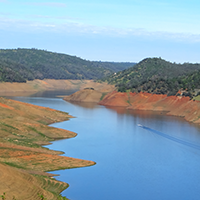
To Survive a Drought, Fix the Price of Water
View the page for this story
The ongoing drought in California has galvanized Governor Jerry Brown to impose mandatory restrictions on domestic water consumption. Agriculture consumes 80 percent of California’s water each year. As independent writer Mark Hertsgaard explains to host Steve Curwood, even though farm allocations have been cut, many farmers are getting that water for cheap, or unsustainably tapping deep aquifers. (14:30)
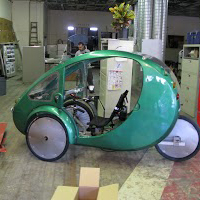
The ELF Gains Traction
/ Helen PalmerView the page for this story
ELF stands for Electric, Light and Fun, And this particular Elf is an invention that launched with a kickstarter in 2013. As Living on Earth’s Helen Palmer reported, it's a human and solar powered covered tricycle that aims to create a commuting revolution, and might just help combat climate change. Now two years on from the Elf’s kickstarter campaign, its designer and developer, Rob Cotter, tells Living on Earth's Helen Palmer how successful the invention has proved, and how much of a contribution it’s making to cutting CO2 emissions. (11:51)

Poetweets: Science Communications in Verse
/ Emmett FitzGerald, Jenni Doering, Naomi ArenbergView the page for this story
Poetry can be created from uniklely source material anywhere, and to celebrate Earth Day and poetry month, we found Poetweets, a website that arranges selections from tweets into verse. Living on Earth reporters Naomi Arenberg, Emmett FitzGerald, and Jenni Doering read verse formed from some prominent science communicators’ tweets. (02:10)
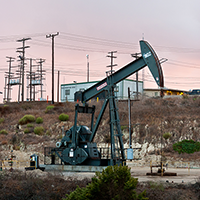
Beyond the Headlines
/ Peter DykstraView the page for this story
In this week’s trip beyond the headlines, Peter Dykstra tells host Steve Curwood about how the oil fracking era might be switching from boom to bust, a climate change-denial stance is seemingly a prerequisite for Republican Presidential candidacy, and how climate deniers still reference a 40 year old, minority theory of global cooling. (05:00)

The 2015 Goldman Environmental Prize Winners
View the page for this story
Every year the winners of the Goldman Environmental Prize are announced just in time for Earth Day, and this year each received $175,000. For the past quarter century the prize has celebrated the efforts of individuals from each of the five most populated continents plus the island nations to protect their communities’ natural resources. Host Steve Curwood speaks with three of this year’s recipients: Howard Wood from Scotland and Jean Wiener from Haiti, who both fought to protect their seas and coasts, and Canadian Marilyn Baptiste who opposed a planned mine on tribal land. (13:15)
Show Credits and Funders
Show Transcript
HOST: Steve Curwood
GUESTS: Mark Hertsgaard, Rob Cotter, Howard Wood, Jean Wiener, Marie Baptiste
REPORTERS: Helen Palmer, Peter Dykstra
[THEME]
CURWOOD: From Public Radio International, this is Living on Earth.
[THEME]
CURWOOD: I'm Steve Curwood. The drought keeps hammering California – a lack of rain and snow is just part of the problem – rules and traditions for sharing the scarce resource also make a solution elusive. And there’s the cost issue…
HERTSGAARD: Look, we have to face the fact that water is unrealistically priced in California; it is still inexpensive. And therefore we are using more than we should and wasting a lot of it.
CURWOOD: Also, catching up on the Elf – the enclosed bicycle where the human gets solar and battery-powered assistance.
COTTER: We’ve sold about 500 units, we’ve delivered them to eight countries, we’re looking at manufacturing in four other countries presently and we’ve prevented from entering the atmosphere somewhere around 200,000 tons of CO2.
CURWOOD: We’ll have that and more this week on Living on Earth. Stick around.
[NEWSBREAK MUSIC: Boards Of Canada “Zoetrope” from “In A Beautiful Place Out In The Country” (Warp Records 2000)]
ANNOUNCER: Support for Living on Earth comes from United Technologies – innovating to make the world a better, more sustainable place to live.
[THEME]
To Survive a Drought, Fix the Price of Water
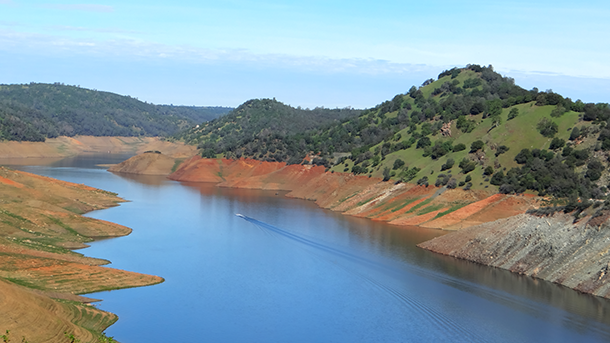
Don Pedro Lake, March 2015 (Photo: Rene Rivers; Flickr CC BY 2.0)
CURWOOD: From the Jennifer and Ted Stanley Studios in Boston and PRI, this is Living on Earth. I’m Steve Curwood. The California drought is expected to get even worse this summer, with more wildfires and tighter water restrictions ahead. Governor Jerry Brown has already imposed water cuts of 25 percent for business and residential use across the state. And last year, surface water for agriculture was cut back by an average of 25 percent, forcing as many as 400,000 acres to remain fallow. The long running drought threatens California’s water-hungry agriculture, which grows as much as half of the fresh produce consumed in the US, as well as billons of dollars worth of milk, nuts and wine grapes. Mark Hertsgaard has been looking at the California water crisis. He’s an independent journalist, and author of the book "Hot: Living Through the Next 50 Years on Earth".
HERTSGAARD: We're entering the fourth year of the drought and the scientists are saying that this could be the worst drought in this part of the world in 1,200 years. There is no sign that the drought is letting up, and of course it's important to remember here that the geological record tells us that this region of what we now call California has many times over the past thousand years had droughts that last even ten and sometimes as much as 20 to 30 years. So as hard as it is to believe, we could just be at the start of this drought.
CURWOOD: So, Mark what you think about Jerry Brown's recent water restrictions in California? I believe they're unprecedented.
HERTSGAARD: They are unprecedented. It's the first time in history that any California governor has ordered rather than requested restrictions. But, of course Governor Brown has been criticized for the nature of these restrictions. He has imposed restrictions - pretty big ones - on the residential users and he's required that they restrict their water used by 25 percent this year. At the same time, though, the governor’s executive order said to the agricultural sector that it must only submit "plans" for future drought and that's a problem because agriculture is responsible for 80 percent - that's eight zero percent - of all the water that's used here in California. So the criticism has been, "Well, how can you hope to solve the problem if you're leaving 80 percent of the problem off the table?" And agriculture is important but it's only 2 percent of California's economy and when you've got two percent of your economy that is using 80 percent of the water, I don't think that's going to be sustainable.
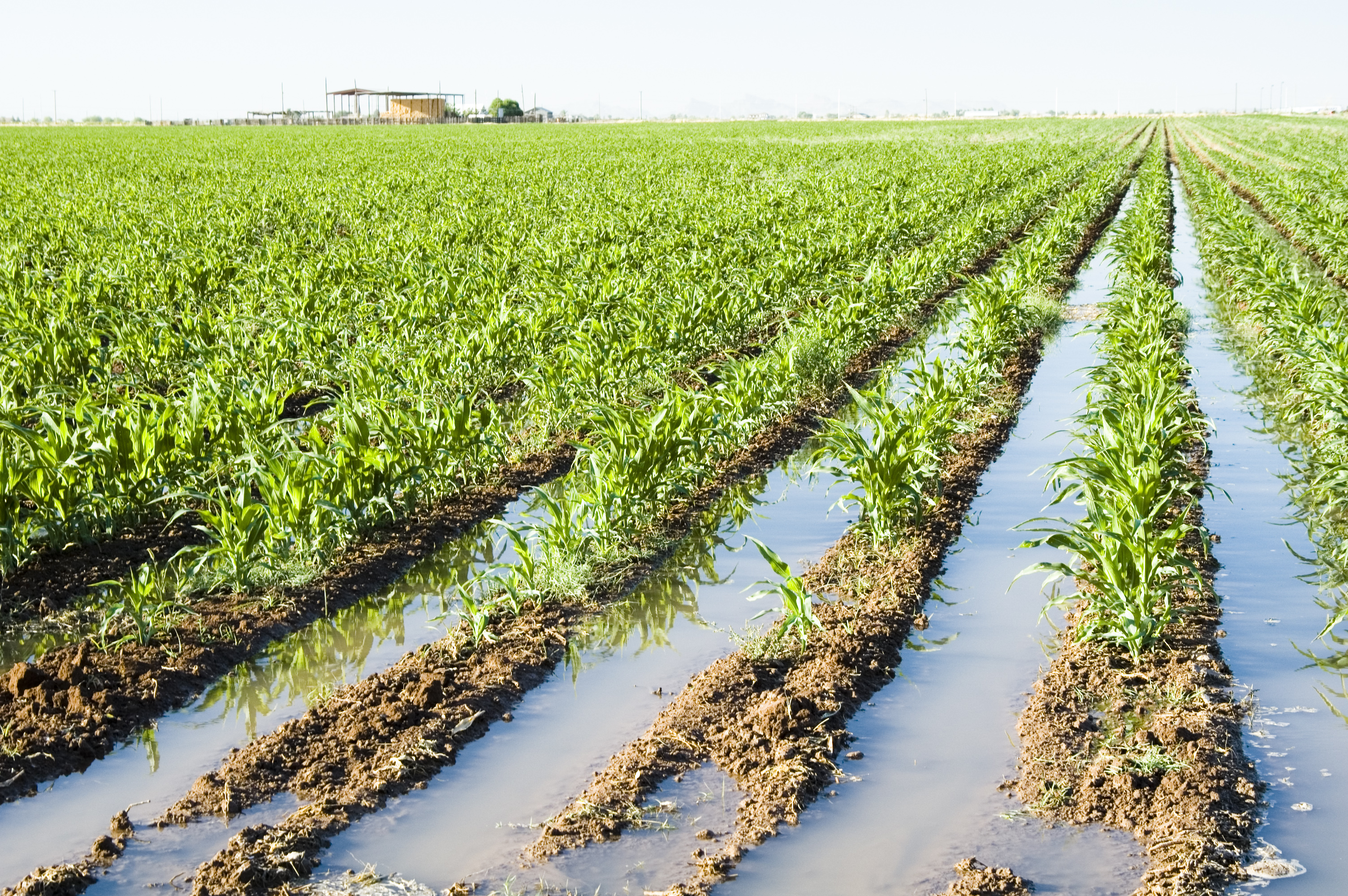
Agriculture is responsible for 80% of California’s water-use, much of it in irrigation. (Photo: Bigstockphoto)
CURWOOD: Now, the residential side is for watering lawns, a lot of it washing cars, only a small amount is consumed as drinking water. On the agricultural side, isn't the formula that food equals water or water equals food? If those guys don't get water they won't be able to produce food.
HERTSGAARD: Well, you would think that, but I found when I dug a little deeper into this in reporting on it that there's no one story out there in the agricultural sector in the Central Valley and, in fact, some of the biggest farmers are literally laughing all the way to the bank, or the quote that I had my story from the pistachio farmer named John Dean said, "I'm smiling all the way to the bank," because these farmers of pistachios and almonds, walnuts, which are pretty thirsty crops, they are reaping record profits, and it's not just because the prices are high this year. It's also because they are literally expanding their acreage in these thirsty crops over recent years. So the big farmers who are able to get ahold of water, they are making money hand over fist even as many of the farmworkers out in the central valley are dearly, dearly suffering. There are communities now, Steve, in the Central Valley where their household faucets no longer give water just mud. So it's a real different picture depending on basically how well politically connected and financially set you are in the Central Valley as to whether agriculture is doing well or not during this drought.
CURWOOD: I know to get the details will take a lot of time here, Mark, but, in brief, how is water priced for agriculture? I understand there are many different ways that give some folks huge advantages and other folks really at a disadvantage.
HERTSGAARD: The water pricing system in California really could fill an entire book. The experts all say that that is though the core of the problem. All the water experts that I interviewed for this story said that look, we have to face the fact that water is unrealistically priced in California it is still inexpensive and therefore we are using more then we should and wasting a lot of it. You can draw an analogy to gasoline prices. When gasoline was a buck 50 a gallon, there were a lot of Americans driving SUVs and other gas guzzling vehicles but when gasoline goes up to $3 or $4 a gallon, suddenly that Prius starts to look pretty good, and you trade in the SUV for the Prius, and that's kind what's going on in California on water now. We still we have a water system for pricing and incentives that is based in the 19th or 20th century and we need to prepare for the 21st century, and one example of that is that there is no single price for water that all farmers pay in California. It depends on how long you had your water rights, what you're doing with them and even what time of year you get the water. So some farmers could be paying as little as $10 an acre-foot and just so you know an acre-foot is about how much water it would take to cover a football field with one foot of water. And other farmers could be paying hundreds of dollars an acre-foot and then it also depends the other big categories: are you getting out water from under the earth or from the state and the federal water projects?
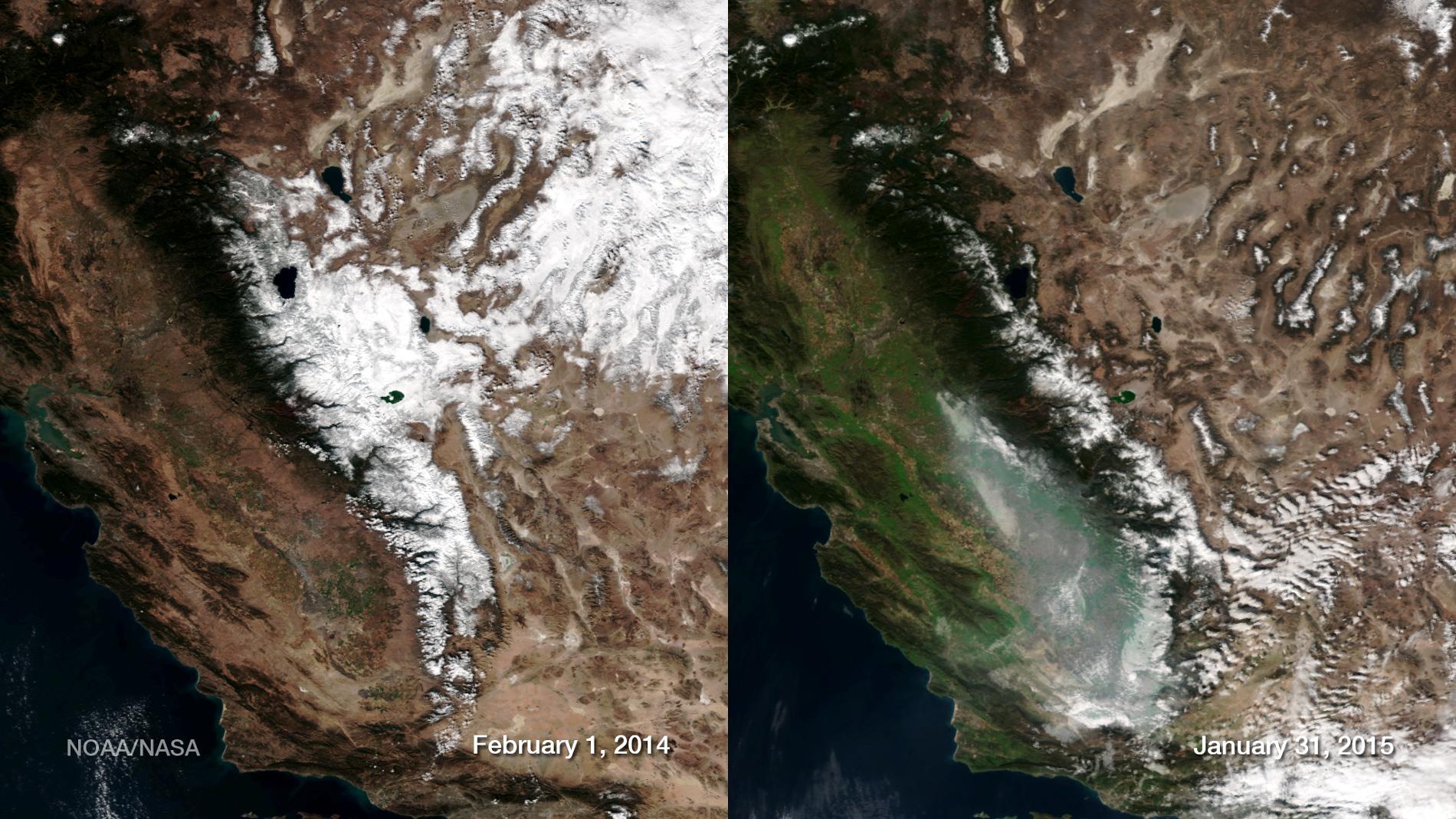
The decline in the snowpack from 2014 to 2015 means that California can expect the drought to continue into this year. (Photo: NOAA satellites)
Governor Brown points out that to his critics that, "Hey, agriculture is already cut back. The state water project is cutting farmers back to 20 percent of their normal allocation in 2015, the feds have cut it back to zero”. And that sounds impressive but it is not stopping the big farmers in the central valley because what they do instead is simply drill deeper wells. And I've been down there in the Central Valley on reporting trips and essentially you've got a kind of an agricultural arms race where farmers are drilling deeper and deeper and deeper wells in order to keep that groundwater coming. And let it be known, the groundwater, they pay nothing for that groundwater. Of course, they do pay for the drilling but the groundwater is free to whoever can take it.
CURWOOD: Tell me more about this use of groundwater, these wells. I take it then that the bigger richer farmers are able to dig deeper, but there must be some limit, some point that aquifer down there is...well, that too will run out of water won't it?
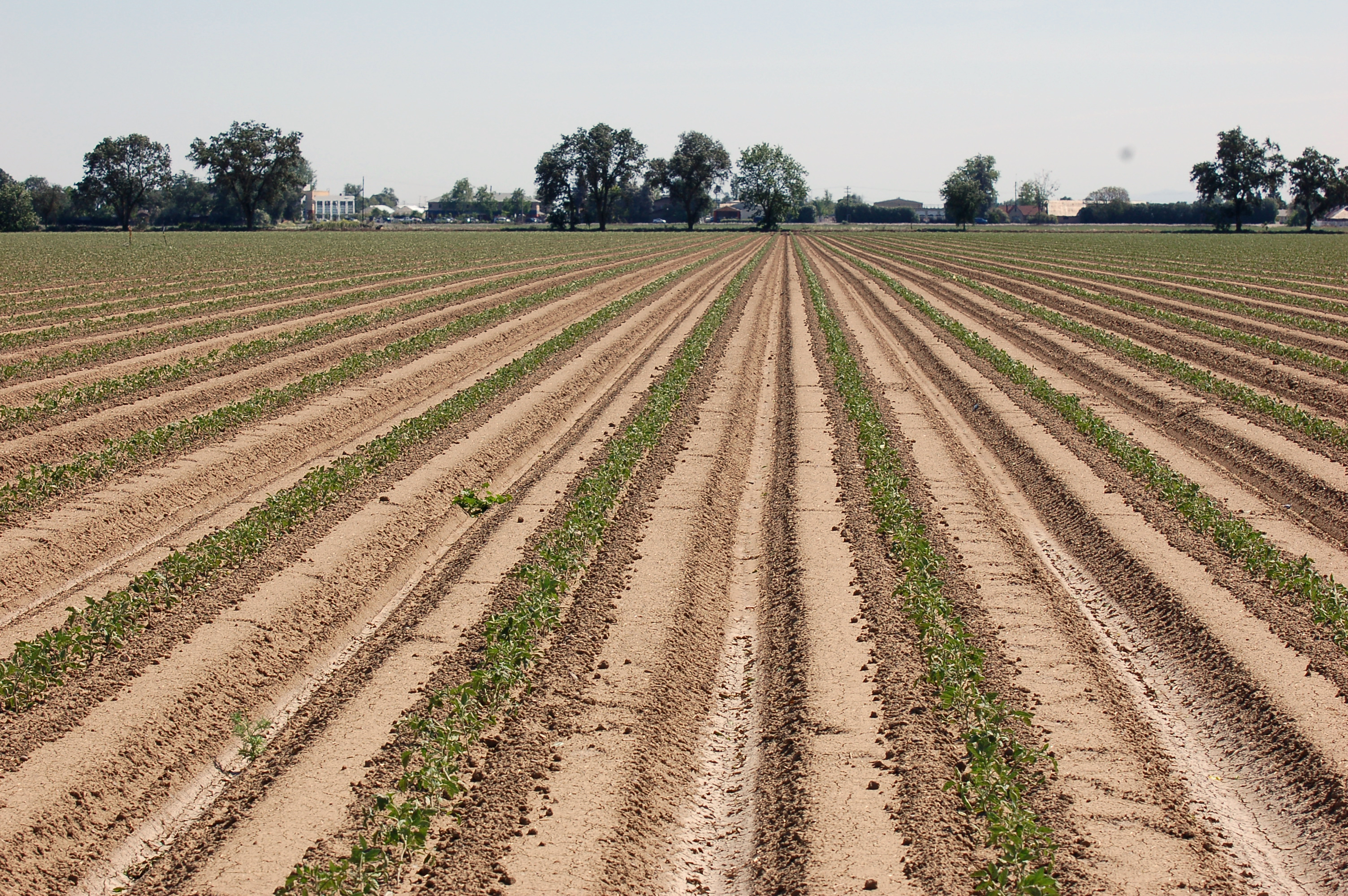
Some farmers are reducing their water consumption by using drip irrigation systems like the one used on this California tomato farm. (Photo: USDA)
HERTSGAARD: I think the groundwater aspect of California's drought is really the big question here, along with pricing. And for many, many years California was the only state in the arid western part of United States to put no limits on groundwater extraction. Zero. Now that changed last fall when the legislature passed a bill the Governor Brown has signed that we'll begin to bring some order to groundwater extractions. At least now we will begin to know how much is being extracted and over time the legislation requires to the extractions to be brought to a sustainable level, but that's not until 2040. Again, some of this criticism comes from the NASA scientist J. Famiglietti who pointed out in the LA Times about a month ago that California only has one year of stored water left, non-groundwater supplies, and we're presumably going to be using that up this year as the drought continues and so what that means is that the big farmers are going to be turning more and more to the groundwater, and that is dangerous not just because our kids are going to need that groundwater to deal with future droughts. The real danger, and this is kind of the doomsday scenario Steve, is that if you extract too much water too fast from a aquifer from under the ground you run the risk of ruining it forever, and if you think it just like drinking water out with a straw if you are you suck up too much of it too fast what happens is that the ground compresses around it, and the danger is that if all of that earth that surrounds the underground water supply compresses, you can essentially collapse the aquifer and render it permanently inaccessible. That would be a nightmare for California, it would be very hard to imagine how significant numbers of people could live in the state going forward if we ruin our groundwater supplies like that, which is why that really has got to be priority number one.
CURWOOD: Now the way forward obviously is conservation. How are the farmers doing along those lines? They put food on the plate to millions of Americans, but, you know, the sophisticated water sparing technologies are a lot of dough and I imagine that's a fair amount of capital expense for farmers to go to drip irrigation and such like that. How are they coping and how is the state prepared to help them cope?
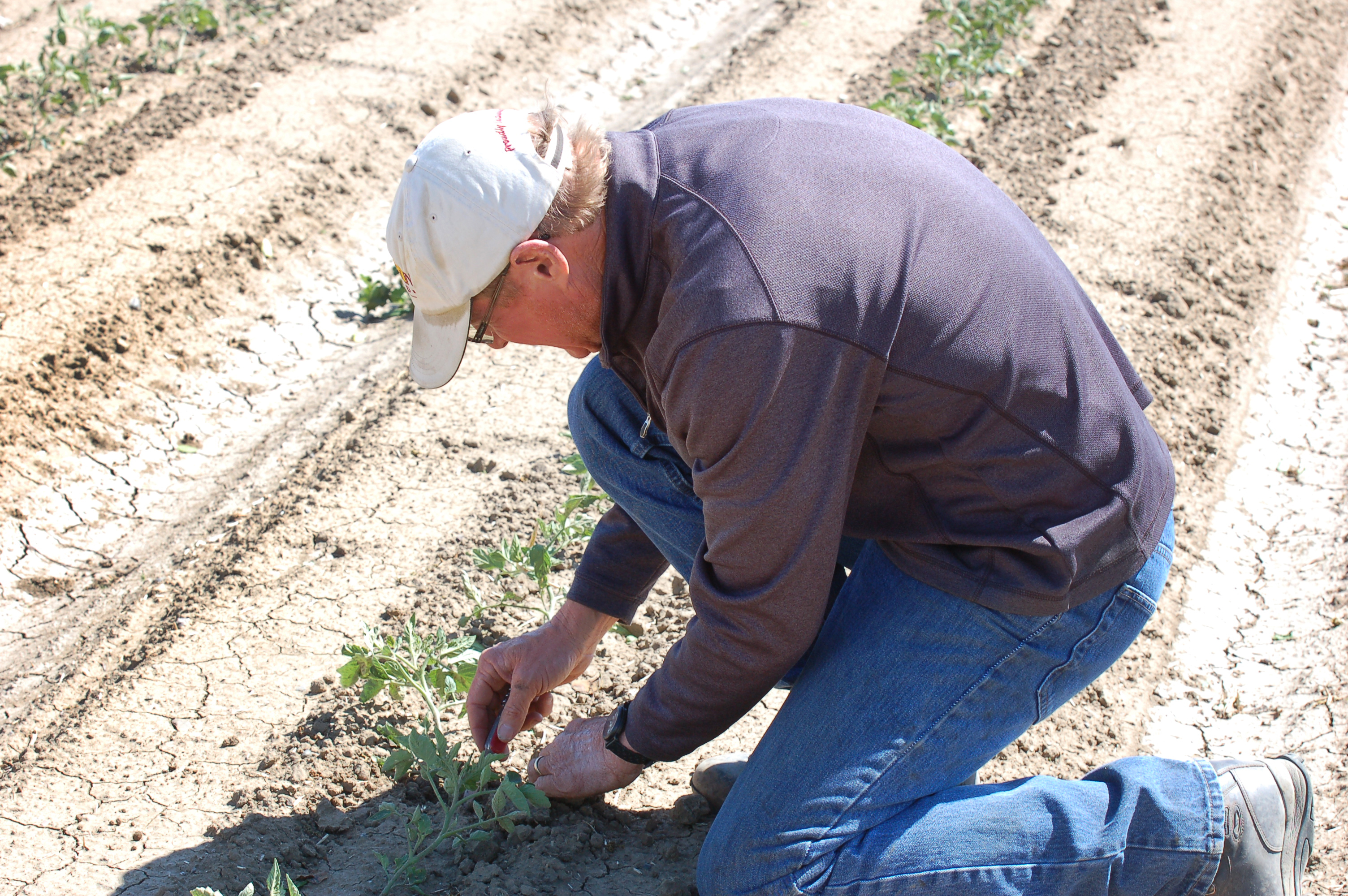
Joe Muller and Sons, Co-Owner Tom Muller checks the condition of his healthy crop of tomatoes that receive underground micro irrigation, in Woodland, CA. (Photo: USDA)
HERTSGAARD: It's interesting; you know, California has been environmental pioneer for a long time, and just like California led the way with energy efficiency, it is beginning to move on water efficiency, and you're right that is clearly the way forward. A new study by the Pacific Institute in Oakland, California, they found that by using just the currently available technologies for improving water efficiency - essentially smarter irrigation, including both drip irrigation and micro spray irrigation instead of flooding the entire field and even the timing of irrigation - that if you use all these we could reduce the agricultural water use in the state by 22 percent. That would mean, had we done that, had we had all those efficiencies in place last year in 2014, the agricultural sector would have had no scarcity of water. The drought's effects would've been basically removed. So there is a lot we can do with efficiency, and in fairness to farmers and to the Brown administration, they say look we're already moving in that direction. And that's true. About half of the farmers in California already use some form of water efficiencies, but there are still the other half who are not, and if you drive through the Central Valley, you'll pass many, many, many acres of almond trees, and you will often see entire fields flooded rather than the kind of micro irrigation. So, there's still a lot of water that is being wasted and that has to be improved. The Brown Administration has rhetorically backed water efficiency and has put a small amount of money where its mouth is. About $20 million has been allocated between last year's budget and this year's budget for the drought to help farmers move in this direction but again that's not going to happen if you don't change the pricing. These big farmers in the Central Valley they know perfectly well that water efficiency saves them money. They're not doing it simply because right now it's cheaper and more profitable for them to waste the water, and so that's really the challenge here. And I think it's a big challenge for Governor Brown as he goes into his final years as governor - and he's a guy who thinks very much about his legacy - can he finally bring some sense to the water system here and prepare California's water system for the 21st century, which as the governor always says the biggest challenge to California in the future is going to be climate change.
CURWOOD: What about Brown's record suggests that he's going to be able to manage this well?
HERTSGAARD: I think that Jerry Brown's history as governor actually points to the most likely solution here. Part of the reason that California is such an environmental pioneer is that Jerry Brown when he was governor the first time in the 1970s pushed through a radical reform of our electricity markets, and in brief he said that we're, from now on, we're going to reward electric utility companies for saving electricity, not for producing more of it. And so, in the '70s they flipped the incentives. As a result California today, 40 years later, we use roughly the same amount of electricity even though our population has doubled since then and economy has tripled in size since then. I think that that is kind of the secret solution if you will to the water crisis. We know that we could use a lot less water if we simply valued efficiency over output, and so what that means is resolving the issues over water rights and the incentive structure and pricing of course. The price has to be higher and the incentive structures have to be sensible.
CURWOOD: Now what about the mix of agricultural products? There are some water-intensive things ranging from almonds to alfalfa, what thought is Governor Brown his crew giving to encouraging the Ag. sector to shift into more water-efficient crops, stuff that grows better in deserts?

Writer Mark Hertzgaard (Photo: Francesca Vietor)
HERTSGAARD: Governor Brown has said explicitly on the record he does not want to tell farmers which crops to plant and not plant. And I must say that most of the water experts that I've interviewed also shy away from that. Again they say, look, let's get the pricing right. If we get the pricing right, then let the marketplace decide what they want to do. If we charge a realistic price for water, that is going to inevitably increase the price of thirsty crops like almonds like alfalfa. Now at that point, leave it up to the market. If the farmers still want to take that chance and if consumers still want to buy almonds if they're suddenly costing $20 a pound rather than $12 a pound, so be it. But most people think that that's a better way to go than getting down into the weeds and trying to tell this farmer and that farmer, plant this don't plant that. It would be a bureaucratic nightmare and I think frankly you get a lot of people complaining about the Big Brotherism. Farmers in particular - you know I grew up on a farm - so this is not about demonizing farmers or demonizing a particular crop. Farmers are pretty bright but you've got to have the incentives right if you want the final results to be true to what's good for everybody in the state.
CURWOOD: Mark Hertsgaard's book is called "Hot: Living Through the Next 50 Years on Earth". Thanks so much for taking the time with us today, Mark.
HERTSGAARD: My pleasure, Steve.
CURWOOD:This story continues to develop, and after we recorded this interview California’s water resources control board began sending letters to about 1500 central valley farmers ordering them to stop taking water from rivers and streams for irrigation.
Related link:
Mark Hertsgaard’s story on California’s water pricing in the Daily Beast
[MUSIC: Ray Charles, You Always Miss the Water When The Well Goes Dry. I Got Da Blues, Ray Charles and Friends, Suite 2014, 2014]
CURWOOD: Coming up...it’s electric, light and fun...and it could help revolutionize urban transit for the green consumer. Catching up with the ELF...stay tuned to Living on Earth.
[CUTAWAY MUSIC: Doug Martsch, Instrumental, Now You Know, Warner Bros, 2001]
The ELF Gains Traction
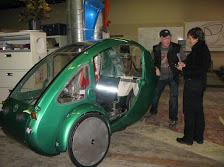
Inventor Rob Cotter shows reporter Helen Palmer the ELF. (Photo: Joanna Rifkin)
CURWOOD: It’s Living on Earth. I’m Steve Curwood. In April, when we celebrate the Earth, and Earth Day, we try to update some intriguing stories we’ve run. Today we’re revisiting the ELF, a human and sun-powered enclosed bicycle that a company in North Carolina launched with a Kickstarter campaign in 2013. Here’s part of our report from Living on Earth's Helen Palmer.
[TRAFFIC SOUNDS]
PALMER: Organic Transit - that makes of the Elf - occupies an old furniture warehouse in downtown Durham, North Carolina. In the huge showroom window is what looks like a large green egg-shaped motorcycle sidecar on top of a racing wheelchair. Now, a sun-powered tricycle sounds like the brainchild of a young alternative engineer, but its inventor hardly fits that mold.
COTTER: Hi Helen, I'm Rob Cotter with Organic Transit.
PALMER: Rob Cotter is in his 50s, a slightly rumpled and unassuming-looking engineer with plenty of hands-on experience.
COTTER: Many years ago I was working for Porsche and BMW more on the race-car side of things - and I was living in Southern Calif.- and they were building the Gossamer Condor and Gossamer Albatross - the pedal-powered aircraft - not too far from me, so I kind of linked up with those folks.
PALMER: That led to a host of new possibilities - Cotter's a working inventor who's learned many skills along the way.
COTTER: I became vice president of land for human-powered vehicles, I built a 62mph tricycle about 30 years ago - and once I realized you could go highway speeds at one horsepower - I realized how inefficient everything is that we do.
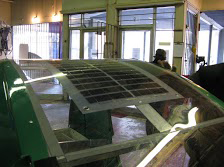
Solar Panels on top of the ELF. (Photo: Joanna Rifkin)
PALMER: That realization and all that experience went into making this new alternative vehicle, the Elf – not something from Lord of the Rings – but an acronym.
COTTER: It's actually Electric, Light and Fun.
PALMER: Light and fun, but not tiny.
COTTER: It's under 4 feet wide, 8 feet long and a little under 5 feet tall.
PALMER: At that height, he says, you sit in traffic at eye level with cars. The open sides and huge front windshield mean you can see, and the electric headlights and indicators mean you can be seen; you're protected by a sturdy aluminum frame that anchors the body panels front and back. There's space behind the driver to put a child seat and it can carry up to 350 pounds of cargo, but the Elf is still a bicycle.
COTTER: It has pedals and a chain and drives a rear wheel, but there's also solar panels and an electric motor to help get it down the road.
PALMER: Rob says the Elf gives people the choice of how much exercise to take - you can use the electric motor to help get up the hills on the way to work - so you don't arrive too sweaty - then let it sit in the sun for the solar panels to charge the battery. And it's not only the Elf's color and its power source that are green.

Steering handles and pedals on the ELF. (Photo: Joanna Rifkin)
COTTER: A lot of materials that go into this are recycled materials - the aluminum's 45 percent recycled, it's just a very efficient package - so efficient that it gets an equivalent of 1800 mpg.
PALMER: But of course, it uses no gas at all: just human-power, sun-power and a battery pack with a 30-mile range. It's not built for highways though - only for local roads, and bike trails, as federal regs say a bicycle can't go faster than 20 miles an hour. Cotter says if enough people who drive about 30 miles a day climbed out of their cars and into an Elf - the effect on greenhouse gas emissions could be startling.
COTTER: Each one of these on the road takes about 28 tons of CO2 out of the atmosphere per year.
PALMER: Compared with an equivalent car?
COTTER: That's right, it mitigates the 28 tons - so 100 of these on the road are equivalent to a 4-megawatt wind turbine at about 20% of cost.
PALMER: Ah cost! That's always one of the big questions about any new technology.
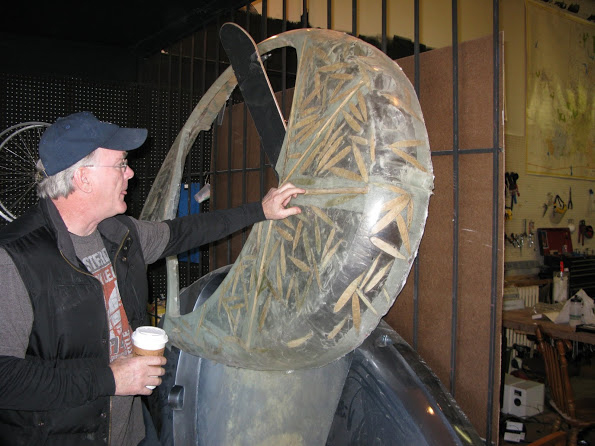
Rob Cotter with ELF side panel; note embedded bamboo leaves. (Photo: Joanna Rifkin)
COTTER: The base price is $4000 - and basically that's like the wholesale price - but we have over 400 orders or reservations currently, just from our website.
PALMER: And that was before the Kickstarter campaign got underway - they reached their $100,000 funding goal in 12 days and 40 people have actually paid for the vehicles.
By now I really wanted a personal test-drive in this powered trike – though I was a little apprehensive.
COTTER: We call the green one the green onion.
PALMER: How safe do you think they are if somebody runs into them?
COTTER: Safer than a bicycle – so this is like riding inside a bike helmet. So let me pop this door open here…
PALMER: But with hands full of recorder and microphone - I wasn't sure if I could actually ride or steer the thing - indeed - I couldn't even work out how to climb into it.
COTTER: So what I do - it's kind of like getting into a kayak - so I take a big step - keep your feet on the pedals - it's much the safest to keep your feet on the pedals.
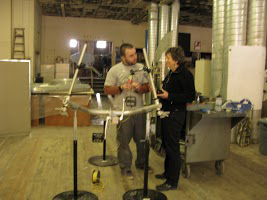
Mechanic Brian Highfill with reporter Helen Palmer. (Photo: Joanna Rifkin)
PALMER: So, feet on the pedals - and microphone stuffed inside my jacket - I was ready:
COTTER: So make a left at the light - up to the bull - see that bull statue? Make a right after that.
PALMER: And I set off pedaling unsteadily into the traffic.
[TRAFFIC SOUNDS]
PALMER: Wow – I’ve come to a red light so I’m stopping - she's letting me go. That’s amazing. I'm turning in front of the traffic. Oh, wow! This is very wonderful. OK, it’s quite a bit of actual pedaling so it’s not easy - but I could of course put on electric motor so let’s try that. Oh, yes, oh my goodness, I just put the motor on and it’s great! OK, there’s nothing coming so I can turn round here Oh it’s easy! You get the hang of it in like three minutes. I'm being followed by a fire engine.
Well, except for the fire-truck, it was fun, but more challenging than I'd expected and given the turn signals and the traffic, there was a lot to remember. But it's certainly easier than learning to ride a bike - and the electric power on the hills was great.
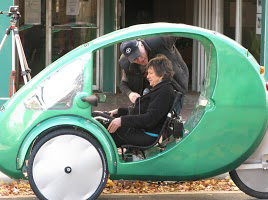
Instruction from Rob Cotter (Photo: Joanna Rifkin)
So don't be surprised to see a solar-pedal-powered trike heading down a bike-path near you soon. For Living on Earth, I'm Helen Palmer in Durham, North Carolina.
[TRAFFIC SOUNDS]
CURWOOD: Helen joins us now in the studio. So that was back in January 2013. What’s happened since?
PALMER: Well, as you remember they were just at the end of their Kickstarter campaign, so I called up Rob Cotter, the CEO of the company and here’s what he told me.
COTTER: Since then we’ve sold about 500 units, we’ve delivered them to eight countries, we’re looking at manufacturing in four other countries presently and we’ve prevented from entering the atmosphere somewhere around 200,000 tons of CO2.
PALMER: Well, I know one of the plans you had was to manufacture in other urban centers around the US. Have you managed to get that off the ground?
COTTER: We've done some of that. We actually worked with an organization in San Jose that trains homeless people to become bicycle mechanics, so we went there as kind of a test pilot to see who could build this and how, and in a week's time we taught them how actually to build ELFs, and maintain them, and service them, and all the tooling it takes to do that, and now we are in talks with organizations in Holland, in Belgium, New Zealand and Fiji, to be building them there as well in other parts of the US.
PALMER: So this is obviously something that's caught a wave in other countries as well. What response have you had from other countries about the Elf?
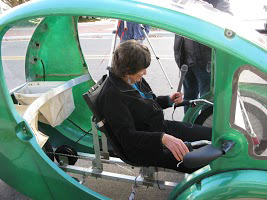
"Where can I put the microphone?"
Helen Palmer prepares to test-drive the ELF.
(Photo: Joanna Rifkin)
COTTER: So, I think one thing we have to be realistic about is that pretty much every country is a better market than the US. Even though there's a renaissance taking place here with bicycles in the US and the mindset of people wanting to live in urban areas and have a smaller footprint so to speak, we don't really have the infrastructure of most other countries, and we don't have the mindset of drivers that allow bicycles to have a bigger portion of the road. So, the response we've gotten from other countries oftentimes is "This can't be made in the US. This must be made in Germany."
PALMER: What is it that we're missing that other countries are getting, both in terms of infrastructure and attitude?
COTTER: So, over the past 75 years or so, we've become a very auto-centric culture. We don't have a lot of bike paths, we don't have a lot of separated bike paths, we don't have a lot of wide shoulders for bicycles to safely travel on the same routes as automobiles, and then a lot of the drivers are not familiar with cyclists on the road. And as we have more and more cyclists coming on to the roads, many of those are actually not skilled and understand how to ride safety as well. So two of the things that the Elf does is provide weather protection and increases the safety immensely over a conventional bicycle, with the composite shell for safety, with the visibility of the higher profile body and then with the turn signals and brake lights and all those things.
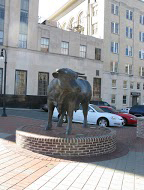
Durham's mascot - the Bull. (Photo: Joanna Rifkin)
PALMER: Now, I know you've had some new developments in terms of the actual, what the Elf looks like, what capacity the Elf has. Tell me what developments you've made since I saw it two-and-a-half years ago.
COTTER: So, in the past 18 months or so, we've made about 110 changes on the basic Elf. Some little tiny details of like different washers and little aluminum tabs to significant changes like we made a two-seater called the two-fer. So, there's all sorts of changes that are happening throughout, in fact, perhaps, since you were involved so early on ...we had a 65 watt panel back then, and now it comes standard with a 100 watt panel and somewhere in the future it will be significantly higher once again.
PALMER: So, tell me what kinds of uses people are putting their Elves to. What are they doing with it that has particularly surprised or interested you?
COTTER: Well, it's really amazing. People are using them all winter long in places like Canada. They're pulling trailers, 500, 600 pound trailers around with snow-blowing equipment and yard equipment on there. They turn them into food trucks. There's a gentleman in Pasadena that has a gelato freezer on the back...it's kind of a solar-operated freezer he sells his gelato out of. One gentleman rode from Ontario, Canada, to Key West, Florida, on his Elf all on secondary roads and bike paths. But the thing that amazes me most I think is people with disabilities that are using the Elf to increase their mobility. So, this one woman, she broke both her legs in 20 places and doctors said she would never walk again without assistance. And she purchased an Elf, she lowers herself in it, and takes off on electric power, and when she can she goes ahead and just rotates the pedals. And six months later, she's riding 22 miles a day and able to walk without a cane.
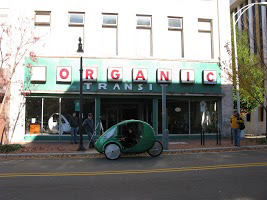
The Elf outside Organic Transit's showroom (Photo: Joanna Rifkin)
PALMER: This must be very pleasing to you as the father of the Elf.
COTTER: Oh, it is. Yes, and it's just always continually amazed with what people are doing with them. Absolutely.
PALMER: So, what do you think the future is?
COTTER: So for us, if we're not incredibly successful, we're not having the impact on climate change that we would like to have. So our goal is to have tens of thousands of units, and also different models - the truck model, the van model, or even just a much more ecological golf cart. And then ultimately somewhere down the road we'd build a fully enclosed three-wheeled motorcycle that would do highway speeds and have a range of 250 miles. And all these are filling that space between a bicycle and a car that are zero pollution, that are very economical to maintain and run and are supplemented in large part by solar.
PALMER: So, Steve, Rob Cotter’s got big plans – and he’s made great improvement on the basic Elf – but as a result the price has gone up from $4,000 to more than $5,000!
CURWOOD: Well, that’s business isn't it? Living on Earth’s Helen Palmer. Thanks so much.
Related link:
Organic Transit's ELF
[MUSIC: America, Ventura Highway, America the Complete Greatest Hits, Warner Bros, 2001]
Poetweets: Science Communications in Verse

CURWOOD: This is our final program in April, and we can’t forget that it’s poetry month as well as a time to celebrate the Earth. We recently came across a novel poetic form that must be a sign of the times – Poetweets. They’re the fevered dream of the Brazil Contemporary Art Center in Sao Paolo, you can find them in both Portuguese and English and they consist of a rather random selection of those 140 character messages arranged in sonnet and indriso verse forms. The 14-line sonnet is familiar, and the indriso is a modern 13-line style made popular by the Spanish poet Isidro Iturat. Now, you might not expect that people we follow are exceptionally poetic, but here, for example, is a sampling of tweets from New Scientist arranged as an indriso titled Cleared Land.

Poetweet can create different forms of poetry from tweets. (Photo: screenshot)
Cleared land, by New Scientist (@newscientist)
Was repaired in a face transplant
Dinner? How nice. Yes please!
Be eaten, we'll open the restaurant
It raises serious questions
- how sound is the science?
Right for a UN deal on emissions?
You'll respond to a placebo pill
Why humans dehumanise others.
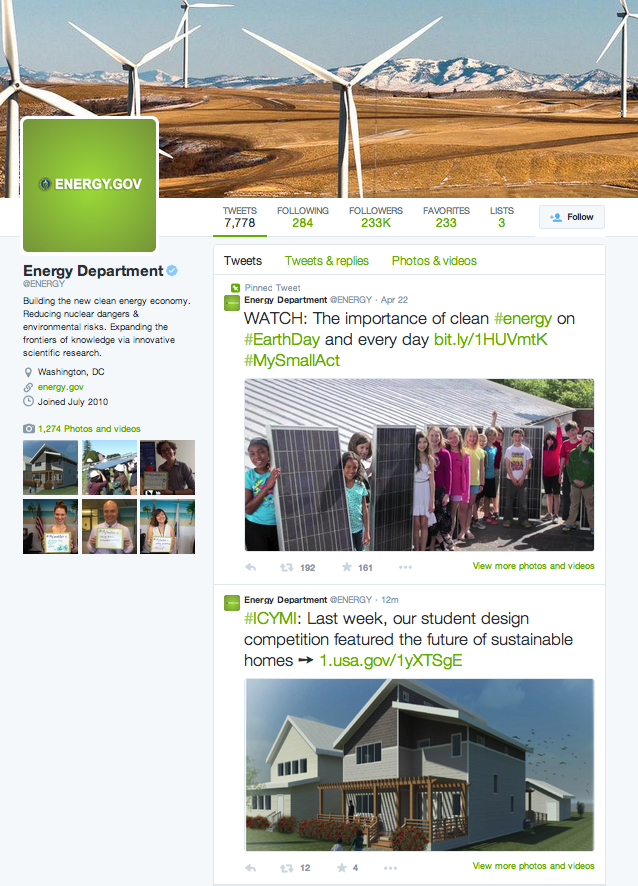
The Energy Department's twitter feed (Photo: screenshot)
CURWOOD: And here are some random tweets from the US Energy Department crafted into a sonnet called Careers.
On science. Use to participate.
In communities across America.
Of and other before you decorate
They had to say: #MadeInAmerica
Part of the equation.
Welding. #AdvancedManufacturing
Are important for our mission.
Your thoughts and questions using
Costs continue to fall
We’re doing to keep the grid safe
In DC? join us on the Mall!
For them -- making the agile.
History of Daylight Saving here
Do? Find out in our first profile
CURWOOD: Finally, all these tweets came, but not in this order, from National Geographic.
Off Jupiter and the moon meets Mars
Of the Day: Lighting the Night
Have been rare collisions of stars:
First-ever mandatory water cuts:
Reactions to ISIS beheadings:
Is a lesson in patience and guts:
Historic water restrictions:
A crucial step in our own survival
CURWOOD: Our readers were Naomi Arenberg, Emmett Fitzgerald, and Jenni Doering.
Related links:
- Poetweet
- New Scientist's Twitter Feed
- National Geographic's Twitter Feed
- US Dept of Energy's Twitter Feed
[MUSIC: Bebel Gilberto, Baby, Bebel Gilberto, Crammed Discs, 2003]
CURWOOD: Coming up...we meet some of the inspiring winners of this year’s Goldman environmental prize. That's just ahead on Living on Earth. Stay tuned.
ANNOUNCER: Funding for Living on Earth comes from United Technologies, a provider to the aerospace and building systems industries worldwide. UTC Building & Industrial Systems provides building technologies and supplies, container refrigeration systems that transport and preserve food, and medicine with brands such as Otis, Carrier, Chubb, Edwards and Kidde. This is PRI, Public Radio International.
[CUTAWAY MUSIC: Medeski Martin and Wood, Shine It, End of the World Party (Just In Case)
Blue Note, 2004]
Beyond the Headlines
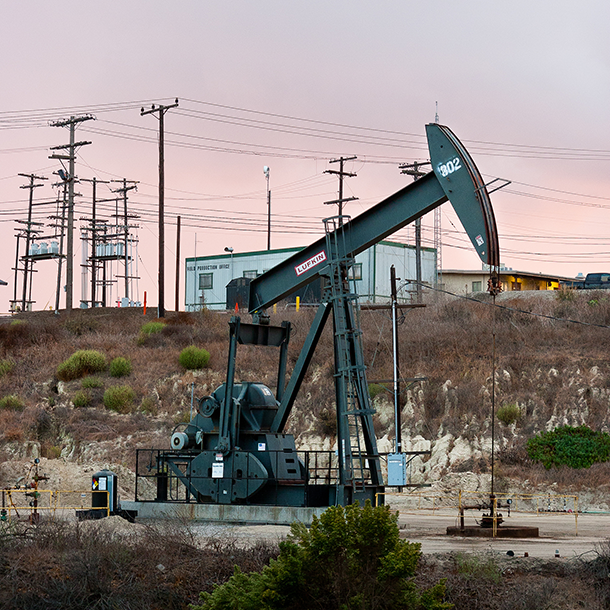
OPEC predicts the US oil and gas bubble might burst soon. (Photo: Erick Gustafson; Flickr CC BY-NC 2.0)
CURWOOD: It's Living on Earth. I'm Steve Curwood. Off to Conyers, Georgia, now where Peter Dykstra’s been looking beyond the headlines. Peter’s with Environmental Health News, EHN.org and the DailyClimate.org; he’s on the line now. Hi there, Peter.
DYKSTRA: Well hi, Steve, there’s a new element in the absolute free-for-all in the global energy biz. We know the scenario: Nuke plants closing in the US while countries like India plan for more nukes; the domestic coal industry is in freefall, wind and solar are taking off – finally! And now, a word from OPEC. The Organization of Petroleum Exporting Countries just issued a prediction that the oil and gas boom in the US spearheaded by the fracking industry, will grind to a halt this year.
CURWOOD: So let’s see, we’ve lived through the dotcom bubble and the real estate bubble, is this the gas bubble? And also, don’t forget, OPEC isn’t exactly a disinterested party. The US used to be their biggest customer; now we’re a big competitor.
DYKSTRA: So true, but it’s not just OPEC dropping the hints. The US rig count is dropping dramatically, there have been big layoffs in fracking centers like North Dakota, and the US Energy Information Agency sees oil prices not getting back to a hundred dollars a barrel, but maybe rising to eighty bucks in the next few years. The rise in prices and the potential decline of fracking is likely why the industry is making a renewed push to drill offshore, in the Atlantic and in the Arctic.
CURWOOD: Still, experts say that fighting climate change is going to require leaving billions and billions of dollars of oil in the ground every year. How does that figure into the industry discussion?
DYKSTRA: Well, bless your heart, Steve. No, the industry isn’t showing any signs of surrendering its assets. But still, it’s a new day, full of different energy equations.
CURWOOD: Okay, so watch this space. What do you have next for us?
DYKSTRA: Steve, I feel a tremor in the force…
CURWOOD: Oh, my. What force is that?
DYKSTRA: The unseen force that makes people who seek the Republican Presidential nomination turn into climate deniers. The list of luminaries who acknowledged climate change, and then flip-flopped includes John McCain, Mitt Romney, Sarah Palin, and Newt Gingrich. But here comes Jeb Bush. Not quite an officially-declared 2016 candidate, but the former Florida Governor came perilously close to acknowledging climate change a week ago.
CURWOOD: Well, one would think that a public figure in a low-lying state like Florida would be quick to point out the risks of doing nothing about sea level rise.
DYKSTRA: Well, tell that to Marco Rubio, Governor Bush’s fellow Floridian and now an official 2016 candidate. Back in 2007, before he became a Senator, Rubio waxed poetic about the “business “opportunities presented by global warming, which is something that last week he said he’s not so sure about and even if the climate is changing there’s nothing we can do about it anyway and the climate is always changing and he’s not a scientist anyway.
CURWOOD: Well okay - but back to Governor Bush for a second, do you think this is a hint at some breakthrough on the political divide over climate change?
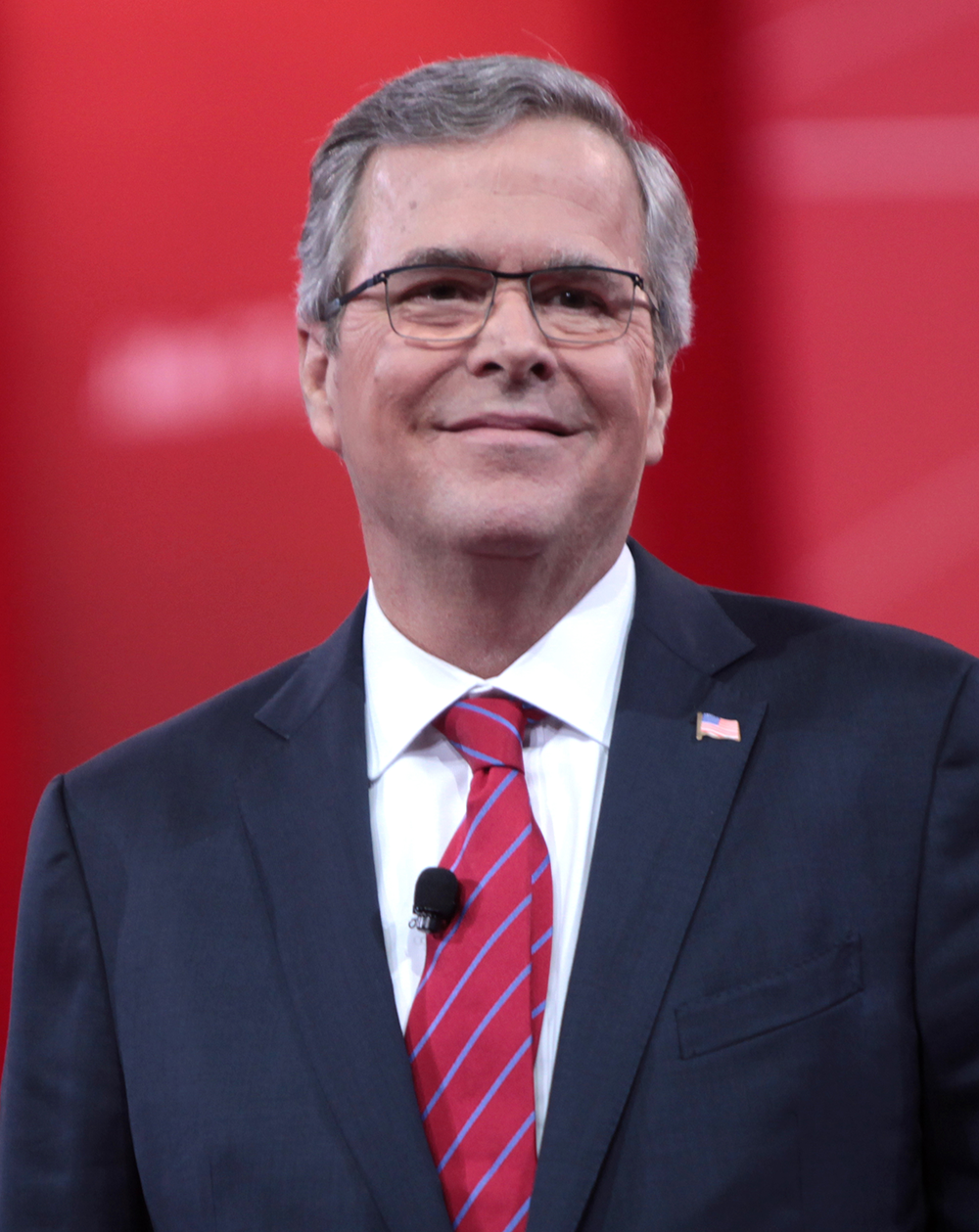
Jeb Bush at the CPAC 2015. (Photo: Gage Skidmore; Wikimedia CC BY-SA 3.0)
DYKSTRA: It’s too soon to tell. One other luminary is making rumblings, though. Mitt Romney advocated strong action on climate when he was Massachusetts Governor, and then he ridiculed it in his Republican Convention speech in 2012, but earlier this year, he flipped again, saying climate change is “a real and major problem.”
CURWOOD: So we shall see. Hey, let’s move on to the history calendar for this week.
DYKSTRA: I wrote a piece FOR Scientific American that’s running on April 28 because April 28 is a red-letter day for climate deniers. Forty years ago, or for some of us, forty pounds ago, on April 28, 1975, Newsweek magazine published its still infamous piece noting that some scientists thought we could be on the verge of widespread global cooling. Forty years later, that nine-paragraph story in the back of the magazine is still an article of faith used by climate deniers to suggest that climate scientists can’t make up their minds about anything.
CURWOOD: And oddly enough, Presidential candidate Ted Cruz just mentioned that Newsweek piece last month. But I recall that even though some scientists asked questions about global cooling back then, it was never really a dominant theory.
DYKSTRA: And when the evidence didn’t begin to add up, scientists moved on. Even at the peak of talk about global cooling, scientific papers projecting a warming planet outnumbered the global cooling papers by about seven to one.
CURWOOD: Well that’s the way science works, your research improves, your data improves, and you go where the evidence leads you.
DYKSTRA: Well it’s the way everything works. People like George Will, Rush Limbaugh, and of course Senator Cruz still drag out this Disco-era magazine piece like it has any validity for anything today. It’s time for even the hard-core climate change deniers to give it up. Can you imagine if we took forty year-old news stories on medical advances as being relevant today? How about computer technology? Things change. We move on. It’s forty years, Steve. It’s a Jay-Z and Beyoncé world, and climate deniers keep dragging us back to the Captain and Tennille.
CURWOOD: Peter Dykstra’s with Environmental Health News, that’s ehn.org and the DailyClimate.org – hey Peter, thanks for taking the time with us today.
DYKSTRA: All right Steve, thanks, we’ll talk to you soon!
CURWOOD: And there’s more on these stories at LOE.org.
Related links:
- OPEC Says U.S. Oil Boom Will End This Year
- Latest EIA Predictions Should Be Taken With More Than A Pinch Of Salt
- Summary of The Lieberman-McCain Climate Stewardship Act
- Sarah Palin acknowledged climate change before seeking a Republican nomination
- Newt Gingrich is now a climate change denier
- “Jeb Bush Came So Close to Acknowledging Climate Change”
- Marco Rubio: global warming’s business “opportunities”
- Marco Rubio doubts manmade global warming, says 'climate is always changing'
- “Mitt Romney Shifts His Position on Climate Change—Again”
[MUSIC: Captain and Tennille, “Love Will Keep Us Together” Reason for Right, A&M 1975]
The 2015 Goldman Environmental Prize Winners

This year’s Goldman Environmental Prize recipients have stopped construction of two major dams, shut down a lead-emitting smelter, established Marine Protected Areas, and thwarted a gold and copper mine. From left: Howard Wood of Scotland, Phyllis Omido of Kenya, Myint Zaw of Honduras, Marilyn Baptiste of Canada, Berta Cáceres of Honduras, and Jean Wiener of Haiti. (Photo: Goldman Environmental Prize)
CURWOOD: Every year the winners of the Goldman Environmental Prize are announced just in time for Earth Day, and this year each received $175,000. For the past quarter century, the prize has celebrated the efforts of individuals from each of the five most populated continents plus the island nations to protect their communities’ natural resources. This year’s winners include a Kenyan woman who shut down a lead-emitting smelter, an indigenous Honduran who championed environmental justice for her people, and an activist who halted construction of a mega-dam in Myanmar. We spoke with the other three of those who won this year: Marie Baptiste, who battled a planned mine on her tribal land, and Jean Wiener and Howard Wood who fought to protect marine areas off their coasts. For all of them, winning the prize was a huge surprise. Here’s Jean Wiener from Haiti.
WEINER: I'd known about the Goldman prize for probably over a dozen years, but as with certainly all of our other co-winners, never thought that it would come to me.
BAPTISTE: I believe I heard about it in the fall when I was called. I've never known about this Goldman prize until then so, yes, it was very much a shock.
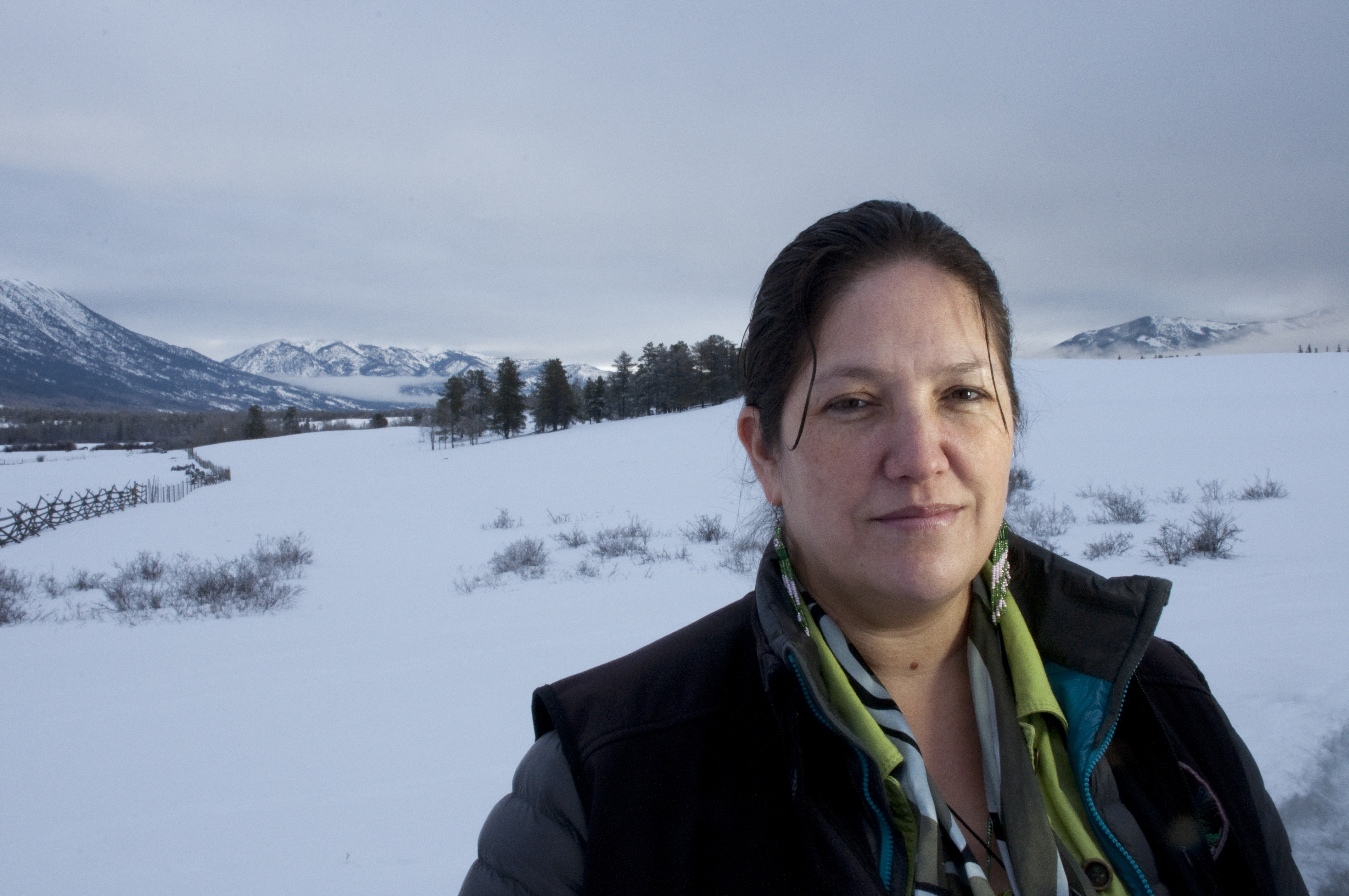
Marilyn Baptiste, 2015 Goldman Environmental Prize winner for North America, led the Xeni Gwet’in community in defeating one of the largest proposed gold and copper mines in British Columbia that would have destroyed Fish Lake, a source of spiritual identity and livelihood for the Xeni Gwet’in. (Photo: Goldman Environmental Prize)
WOOD: Well, when I was phoned up in late autumn, I thought it was a hoax. It took me a few days today to believe it. I certainly didn't think they were going to come to me.
CURWOOD: So, we'll start now with diver Howard Wood of Scotland who responded to the damaging commercial fishing practices occurring along the coast of the Isle of Arran by helping establish Scotland's first community-developed Marine Protected Area. You did a lot of diving as an adolescent. What's changed over the years?
WOOD: Well, I was brought up as a teenager on the Isle of Arran, and as a teenager learned to dive. And when I was diving in the 1970s, to me the seas were full of life, and that was really important because it was how we fed ourselves, but I just loved diving because it was like exploring areas that most of the people on the island couldn't see. But I gradually became aware over the 10, 15 years that our seas were declining and they were declining rapidly due to overfishing and poor fishing practices.
CURWOOD: What convinced you that the fishery needed protecting and how did you work to protect it?
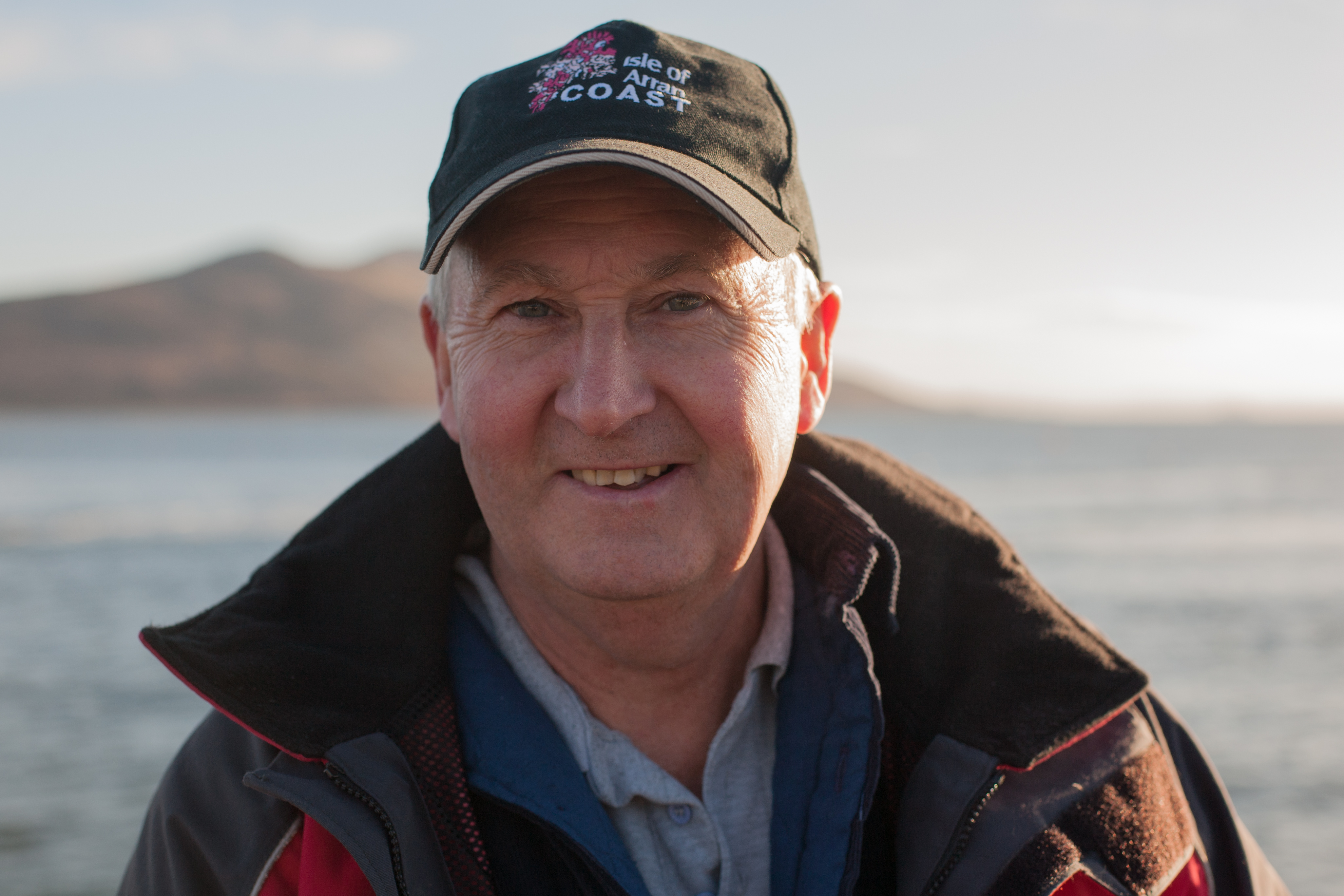
Howard Wood, 2015 Goldman Environmental Prize winner for Europe, spearheaded a campaign that established the first community-developed Marine Protected Area in Scotland, giving citizens a voice in a debate that has been dominated by the commercial fishing industry. (Photo: Goldman Environmental Prize)
WOOD: Well, initially we didn't realize what we could really do about it but the co-founder of our organization called Coast Community of Arran Seabed Trust, my good friend Don MacNeish, returned from New Zealand. And he'd met Goldman winner Dr. Bill Ballantine who had set up the world's first no-take zone in 1973. So myself and Don started in the early 1990s to meet with government officials and try and move this forward. It was very, very difficult and it was only once we spread the word and built community support, that the politicians really started to take note. We have two marine protected areas now. We have the original "no-take" zone, which is called the Lamlash Bay Community Marine Reserve. It is quite a small area. It is only one square mile that has been there since 2008 and the results from the research are very, very, exciting and since last summer we now have the South Arran Marine Protected area, which is 100 times the size.
CURWOOD: You say the first protected area was only a square-mile but it had a tremendous impact. Tell me about the results that you got.
WOOD: Over the first six years, the biodiversity doubled. The species attached to the seabed, the hydroids, the sponges, the macro-algaes, the seaweeds, the complexity of the seabed increased. It was always a problem convincing fisherman...they thought marine protected areas would only work in tropical waters, so we trialed this no-take experiment in a temperate regions and it's been incredibly successful.
CURWOOD: Now as I understand it this marine protected area is Scotland's first and only to be developed by the community itself. How is the Arran community's stake in its protected area influencing its management?
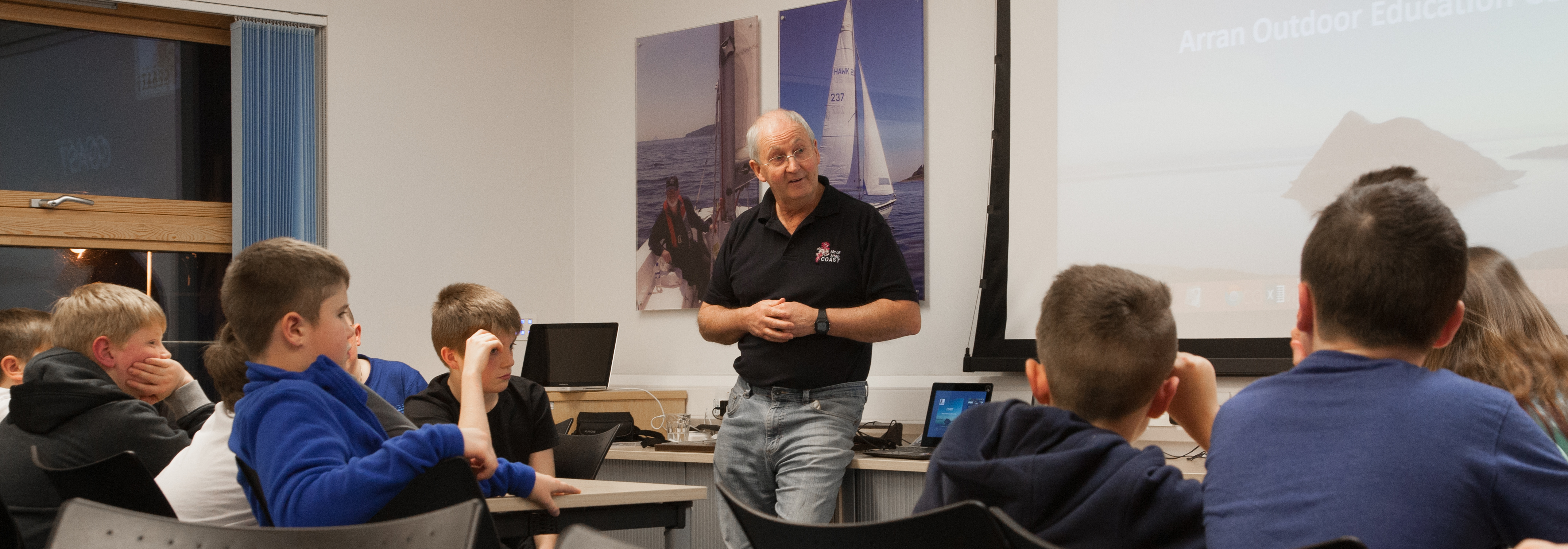
Wood talks to students about the importance of sustainable marine management at a school in Arran, Scotland. (Photo: Goldman Environmental Prize)
WOOD: Well, our organization we don't have the full say over the management. We are in partnership with government organizations and parts of the fishing industry and over the last six-and-a-half years that has been very, very difficult because of the way the Scottish government manages our seas; unfortunately they tend to just listen to the big fishing industry, and if they do not like something happening, they hold a veto. We're still struggling to change so that communities can have a real say in the management but at present the government’s proposals, they're not acceptable to the local community.
CURWOOD: Well, what has been the response of the commercial fishing industry?
WOOD: We have a mixed response. We have had great support from the smaller guys, the shellfish divers, and the creel fisherman, and we've had support from trawling and the scallop dredging industry but that evaporated on the designation of the "no-take" zone. They looked on this as the thin end of the wedge, and that if this would continue, if other communities would have a say in the waters, this was very dangerous to their position of being so powerful with the government.
CURWOOD: I want to turn now to Jean Weiner who is working in Haiti to help people recognize the value of their threatened marine environment. Jean, I understand you helped designate Haiti's first-ever marine protected areas?
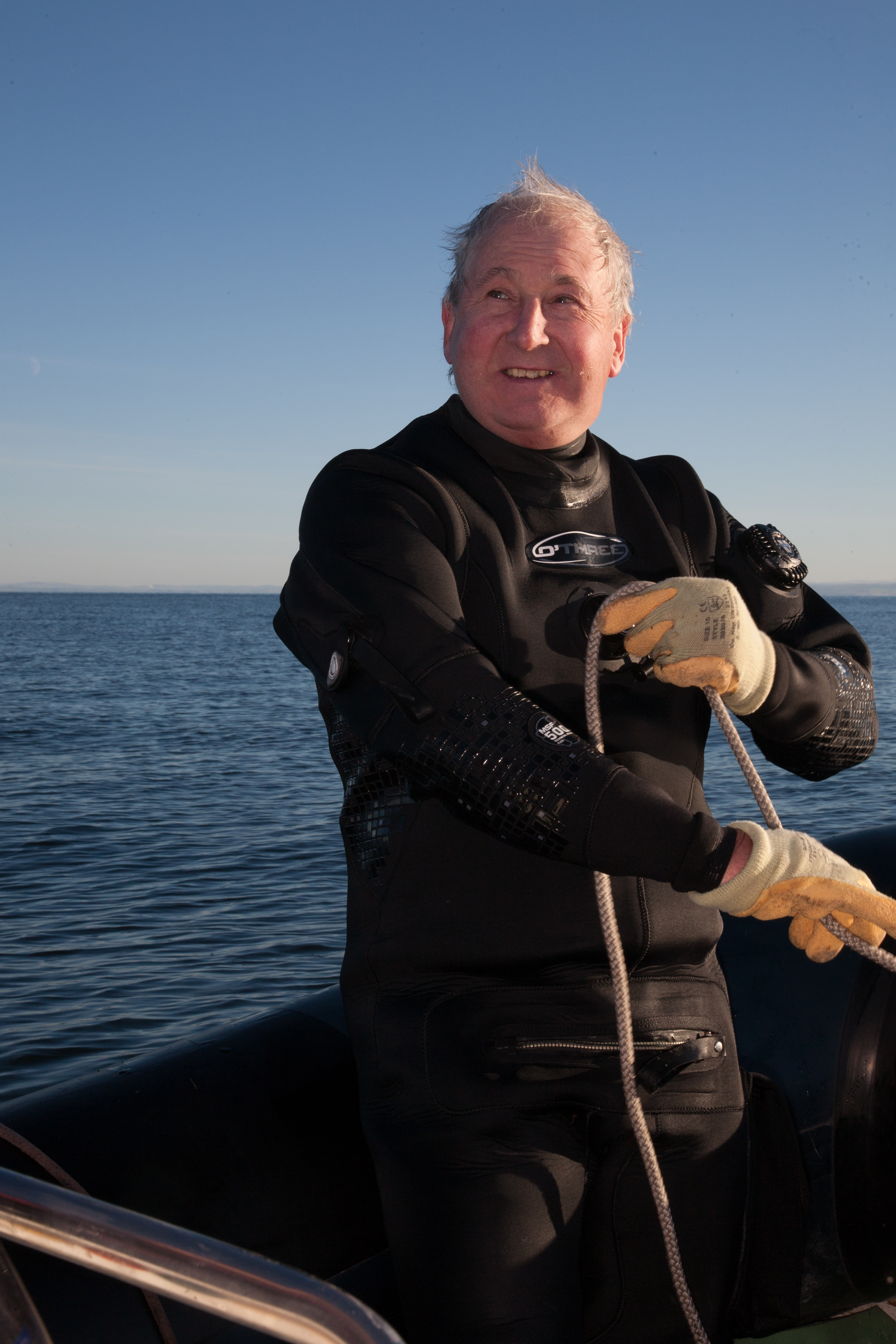
Diving has been a long-time hobby and passion for Wood, who dove in the waters off the Isle of Arran as a teenager. (Photo: Goldman Environmental Prize)
WEINER: Well, in a sense, yes, my organization had undertaken the first surveys for sites, which we thought would be of great importance to preserve not only for their beauty, but for their natural ecosystems and this started back in 2000. So it was a lot of work by a lot of people. We certainly couldn't have done it alone, we needed the government support, we needed the support of the communities. Haiti was the only country in the entire Caribbean, which did not have a marine protected area and we have one of the longest coastlines in the Caribbean and to me at least that was just absurd.
CURWOOD: Jean, take us back to your childhood in Haiti please. Tell us how that his influence how you look at things such as community organizing in marine protected areas.
WEINER: You know, born and growing up in Haiti and spending most of my weekends at the beach with my parents, as I like to say, I was one of those kids who don't had to be yelled at to get out of the water when it was time to go home. So it was snorkeling and being out there with friends and talking to some of the fisherman and seeing firsthand the beauty of the coral reefs, the amount of fish that were in the water with us, and then leaving, going off to college in the United States, returning and seeing already in that short amount of time a serious deterioration in the first of all, what the fishermen...my old fisherman friends were telling me about how bad the fishing had become, seeing pollution, debris, trash, all along the shores, floating in the water and seeing that there was also a lot more destruction of the coastal marine area especially in terms of the degradation of coral reefs and the destruction of mangroves for charcoal production and fuel-wood. So decided to start a Foundation for the Protection of Marine Biodiversity in 1992 and it's just really taken off from there.
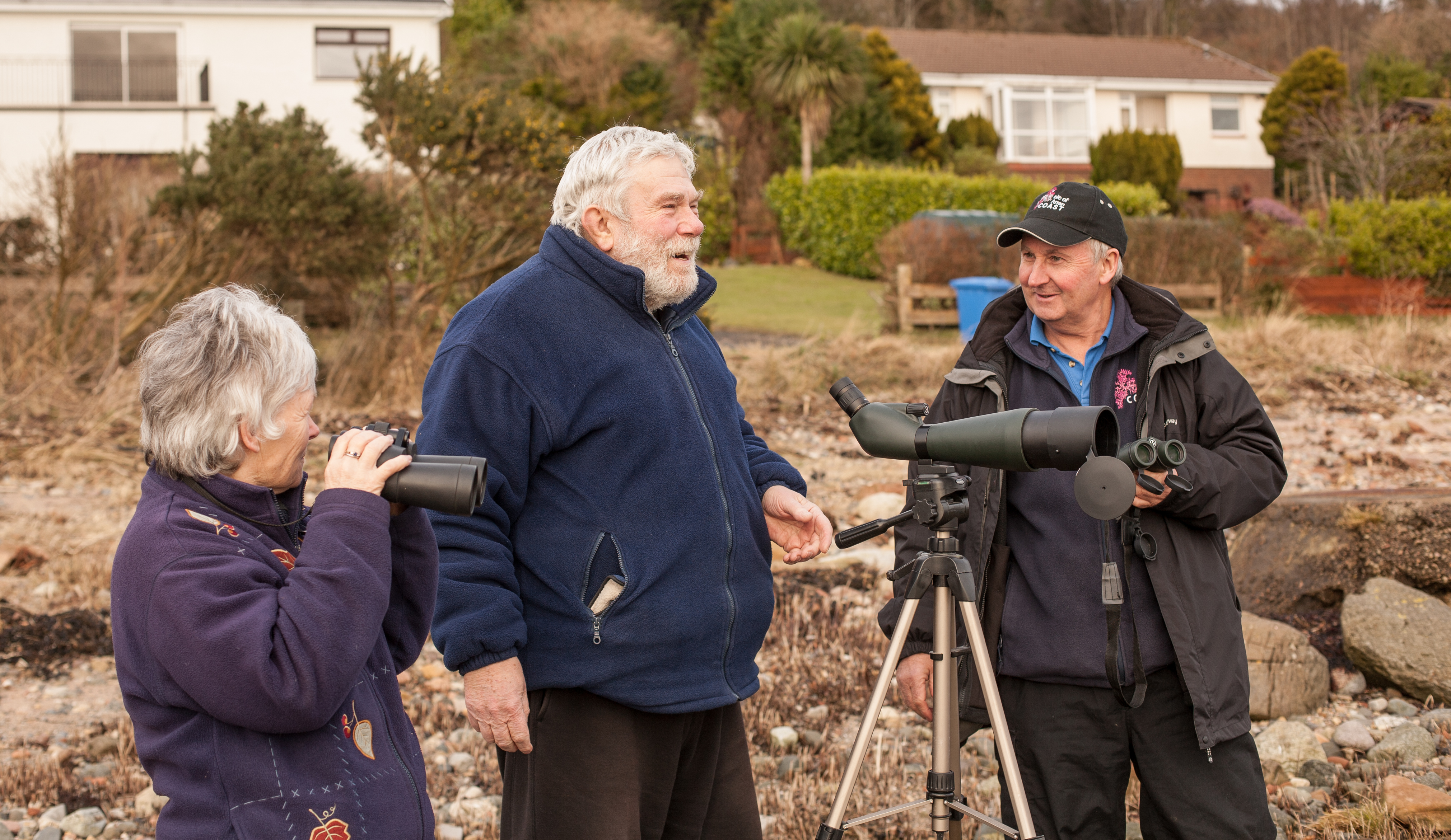
Howard Wood joins locals monitoring for illegal activity in Lamlash Bay’s No Take Zone. In 1995, Wood co-founded COAST, the Community of Arran Seabed Trust, which subsequently led the campaign to establish Lamlash Bay’s No Take Zone. (Photo: Goldman Environmental Prize)
CURWOOD: Jean, Haiti is one of the poorest countries on the planet. I imagine folks there were concerned about how your ideas about marine protected areas would affect their livelihoods. How were you able to explain to people that this would improve the lives economically as well as ecologically?
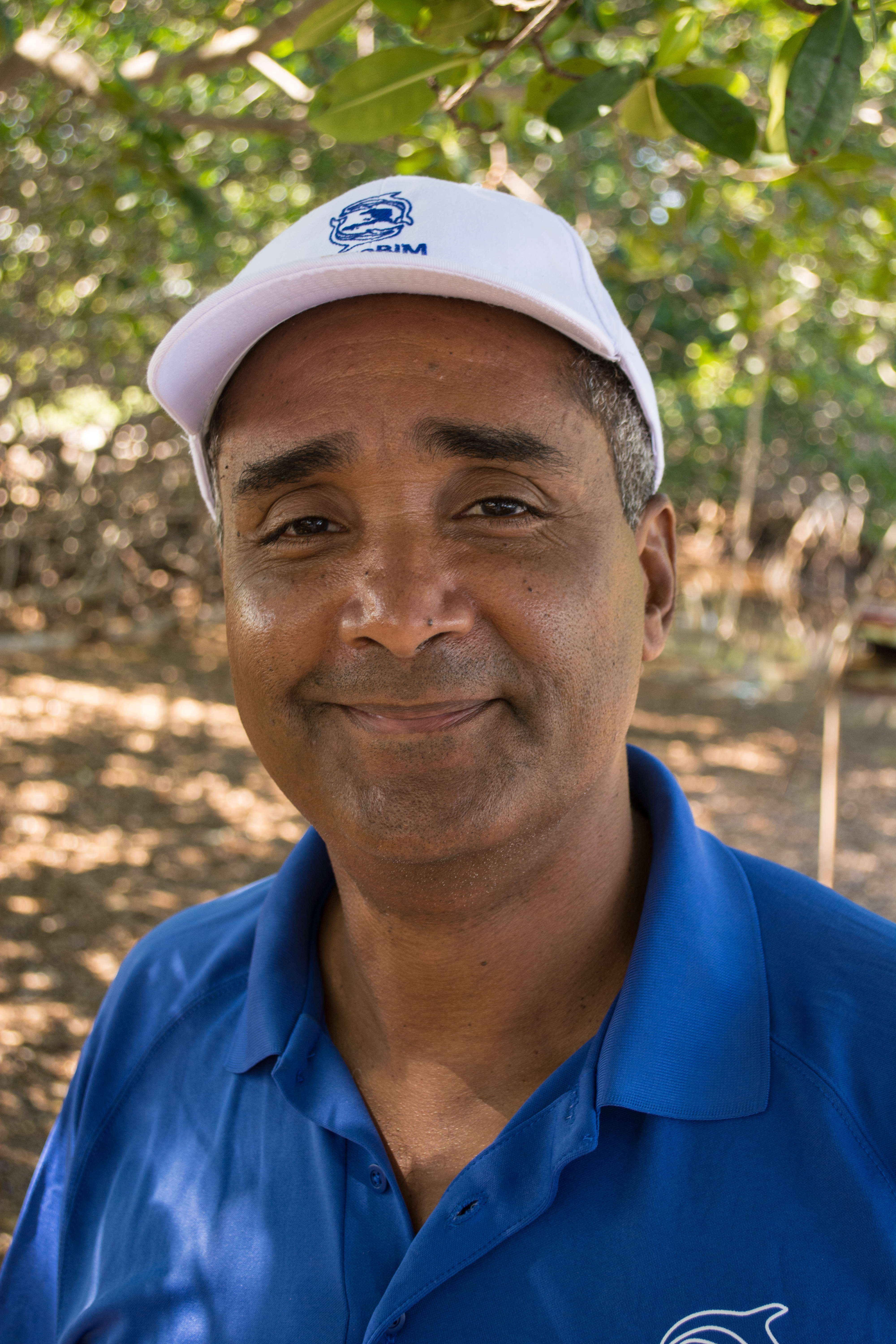
Jean Wiener, 2015 Goldman Environmental Prize winner for Islands and Island Nations, led community efforts to establish Haiti’s first Marine Protected Areas. (Photo: Goldman Environmental Prize)
WEINER: Well, trust me. We're still explaining. There are certain sectors of course who don't believe what we're saying in terms of trying to protect these areas and we have actually started to move away a bit more from marine protected areas and meaning to call them more marine managed areas, because in countries such as Haiti it would be impossible to make the entire area a "no-take" zone because there are so many families reliant upon these resources. So a larger area marine managed area but within that larger area there would be certain areas, which would be “no-take” zones, and areas for fishing and areas for tourism and that type of thing so there would be internal zoning, but convincing the local communities, it's an ongoing process. They know that things can't continue the way they are; fishermen have been going out these days for, they tell me, for two weeks and can't find enough food for half a day whereas they used to go out for half a day and find enough food for two weeks. They've realized that their livelihoods are in serious jeopardy and in certain communities they're actually seeking us out.
CURWOOD: Thanks, Jean. Let's turn now to Marilyn Baptiste, a First Nations tribal leader who defeated three attempts by a formidable mining company to construct British Columbia's largest gold and copper mine. Marilyn, what drove you to stand up against Taseko Mines Limited and the industry friendly BC regional government?
BAPTISTE: It is our duty and responsibility first and foremost to protect our environment and protect Mother Earth who provides for us and to protect our future generations yet unborn. I've learned this basically all my life. My late dad was chief since before I was born, so I've been born into it. As indigenous peoples, that's a part of our duty and responsibility.
CURWOOD: The company that wants to put in this mine calls it “The Prosperity Mine”. Your views on that title and what it would mean?
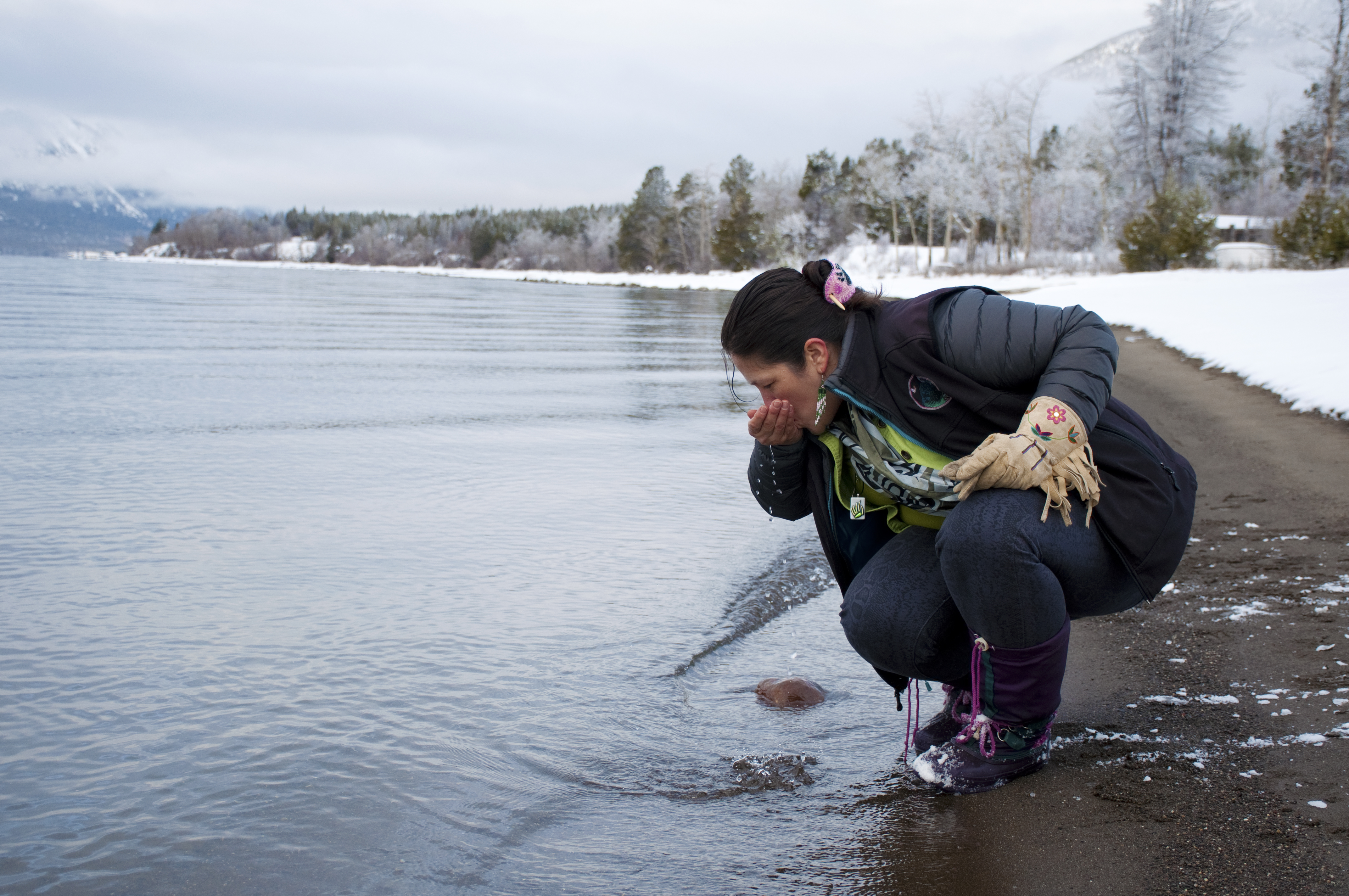
Marilyn Baptiste takes a drink out of Chilko Lake, the Tsilhqot’in’s main watershed in the heart of Nemiah Valley, British Columbia, where Xeni Gwet’in territory became ground zero in Taseko Mines Limited (TML)’s long quest to build a massive open-pit gold and copper mine. (Photo: Goldman Environmental Prize)
BAPTISTE: What it would really mean is a destruction of our territory, the destruction of the environment, the wetlands, our wild rainbow trout as well as our wild salmon in the Taseko system, our grizzly bear, our hunting grounds, moose and deer, our gathering grounds for berries and medicines, the land for which we teach our children where I've been taught, our culture, it would be the destruction of who we are, it would be also the destruction of our future generations.
CURWOOD: So how did you organize your community to engage with the Canadian Environmental Assessment Agency on the environmental review of this mine proposal?
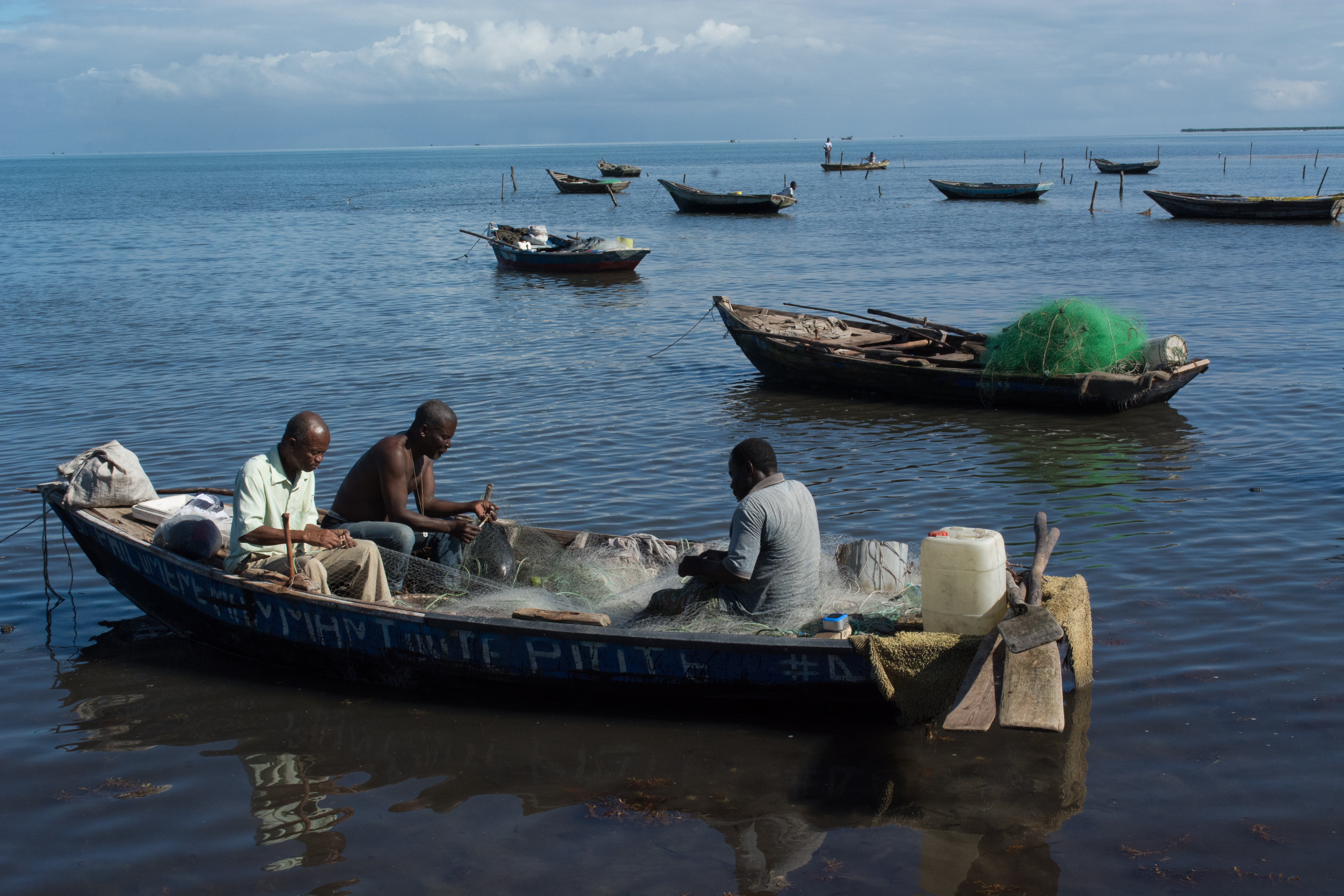
Haitian waters are so overfished that fishermen use nets with holes as small as 3/8” to catch whatever they can to feed their families. (Photo: Goldman Environmental Prize)
BAPTISTE: A lot of it was bringing in people who were in the fight to protect their land. Anne Marie Sam is a co-founder of the First Nations Women Advocating Responsible Mining. She came to our community with Amy Crook and presented to our people how they were putting their information together for an environmental assessment in their territory north of us. Our people really appreciated that insight and that review and their direction from our elders and our people at that time was to work through the process as best we could, to network and work with other people such as Anne Marie Sam.
CURWOOD: I gather that when the Europeans settled that part of Canada at your nation never signed a treaty, that it's still your land.
BAPTISTE: That is correct, we have not gone into treaty and our nation has never intended on selling our territory and that is not a part of our duty. BC is indigenous lands and BC is not for sale.
CURWOOD: So what does the Supreme Court decision mean in terms of the land claims there?
BAPTISTE: That is very, very important to all indigenous peoples. That means that the Supreme Court of Canada has recognized title to a large portion of territory, 1,700 square kilometers. On the other hand, we still have to work through how this is going to develop with the current governments.
CURWOOD: This next question is for all of you. This kind of work is loaded with some pretty intense challenges, but what gave you the courage to go on in those darkest hours? Howard?
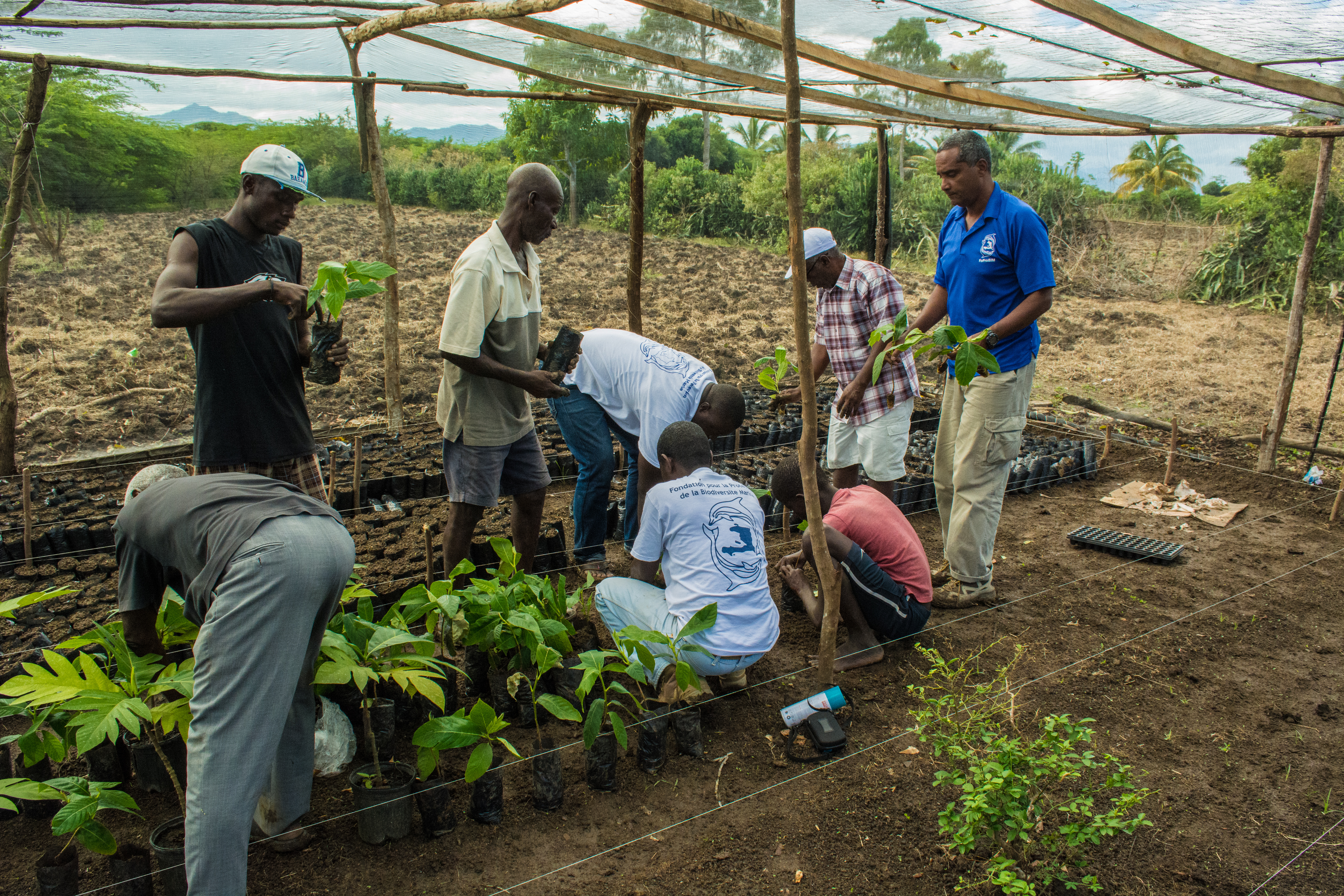
Jean Wiener and FoProBiM staff show residents how to plant breadfruit tree seedlings at a nursery in Caracol, Haiti. FoProBiM, founded by Wiener in 1992, creates small-scale enterprises such as tree nurseries and beekeeping so that Haitians can have promising livelihoods without relying on fishing and mangrove harvesting. (Photo: Goldman Environmental Prize)
WOOD: It slowly became more than just environmental. It became more of a social justice matter that you know myself and my colleagues and then people on the island, we just knew what was happening was not right and I received this award, but I probably received this award because I'm the most stubborn and I would not give in.
CURWOOD: Jean?
WEINER: In Haiti, the problems that everyone faces is in your face all day long, all year long and especially in the areas where I love to be the most, out in the coastal marine areas. I couldn't just sit back and do nothing. There is no doubt that you will be discouraged often, but you have to keep on going.
CURWOOD: How about you, Marilyn?
BAPTISTE: Well, I just have to add simply that it is very important to stand up for what you believe in and you're not here for yourself, you're here for your many generations forward and that's what we are impacting, that's what we destroying if we do not make that stand and do something to help out.
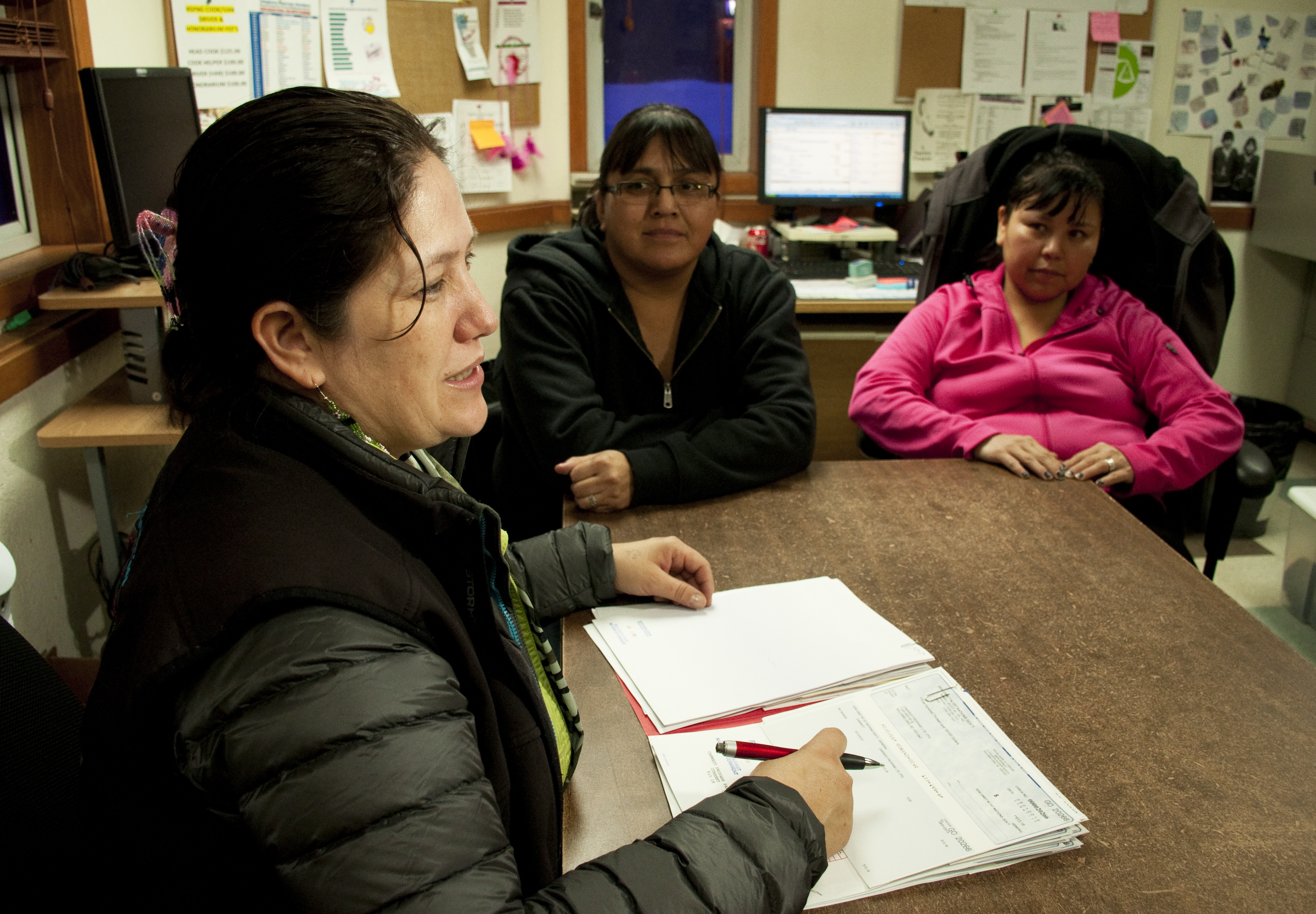
Marilyn Baptiste with her colleagues Pam Quilt and Brenda Lulua at the Xeni Gwet’in Government office. Baptiste co-founded First Nations Women Advocating Responsible Mining (FNWARM), in the thick of TML’s relentless pursuit of the Prosperity Mine project. (Photo: Goldman Environmental Prize)
CURWOOD: Marilyn Baptiste, Jean Weiner and Howard Wood, are three of this year’s six recipients of the Goldman Environmental Prize which honors individuals struggling to win environmental victories against considerable odds. Thanks to all of you for speaking with us today.
WEINER: Thank you.
WOOD: Thank you. It's been a pleasure.
BAPTISTE: Thank you.
Related links:
- The Goldman Prize
- Community of Arran Seabed Trust (COAST)
- Fondation pour la Protection de la Biodiversite Marine (FoProBiM)
- First Nations Women Advocating Responsible Mining
[MUSIC: Coldplay, "High Speed", Parachutes 2000]
CURWOOD: Next time on Living on Earth, scientists think our increasingly noisy oceans may be stressing endangered whales
NOREN: If you have multiple incidences where you’re increasing your vocals to compensate for a noisy environment, you could have some increased need to find more fish.
CURWOOD: The energy cost our industrial activities impose on other creatures -– next time on Living on Earth.
[MUSIC: Esquivel, April in Portugal, Cabaret Mañana, BMG 1995]
CURWOOD: Living on Earth is produced by the World Media Foundation. Our crew includes Naomi Arenberg, Bobby Bascomb, Emmett Fitzgerald, Lauren Hinkel, Helen Palmer, Adelaide Chen, Jenni Doering, John Duff, James Curwood, and Jennifer Marquis. Our show was engineered by Tom Tiger, with help from Jake Rego Noel Flatt and Jeff Wade. Alison Lirish Dean composed our themes. You can find us anytime at LOE.org - and like us, please, on our Facebook page - it’s PRI’s Living on Earth. And we tweet, but not in poetry, from @LivingOnEarth. I'm Steve Curwood. Thanks for listening.
ANNOUNCER1: Funding for Living On Earth comes from the Grantham Foundation for the protection of the environment, supporting strategic communication and collaboration in solving the world’s most pressing environmental problems. The Kendeda Fund, furthering the values that contribute to a healthy planet, and Gilman Ordway for coverage of conservation and environmental change. Living on Earth is also supported by Stonyfield Farm, makers of organic yogurt, smoothies and more; www.stonyfield.com.
ANNOUNCER2: PRI. Public Radio International.
Living on Earth wants to hear from you!
Living on Earth
62 Calef Highway, Suite 212
Lee, NH 03861
Telephone: 617-287-4121
E-mail: comments@loe.org
Newsletter [Click here]
Donate to Living on Earth!
Living on Earth is an independent media program and relies entirely on contributions from listeners and institutions supporting public service. Please donate now to preserve an independent environmental voice.
NewsletterLiving on Earth offers a weekly delivery of the show's rundown to your mailbox. Sign up for our newsletter today!
 Sailors For The Sea: Be the change you want to sea.
Sailors For The Sea: Be the change you want to sea.
 The Grantham Foundation for the Protection of the Environment: Committed to protecting and improving the health of the global environment.
The Grantham Foundation for the Protection of the Environment: Committed to protecting and improving the health of the global environment.
 Contribute to Living on Earth and receive, as our gift to you, an archival print of one of Mark Seth Lender's extraordinary wildlife photographs. Follow the link to see Mark's current collection of photographs.
Contribute to Living on Earth and receive, as our gift to you, an archival print of one of Mark Seth Lender's extraordinary wildlife photographs. Follow the link to see Mark's current collection of photographs.
 Buy a signed copy of Mark Seth Lender's book Smeagull the Seagull & support Living on Earth
Buy a signed copy of Mark Seth Lender's book Smeagull the Seagull & support Living on Earth

